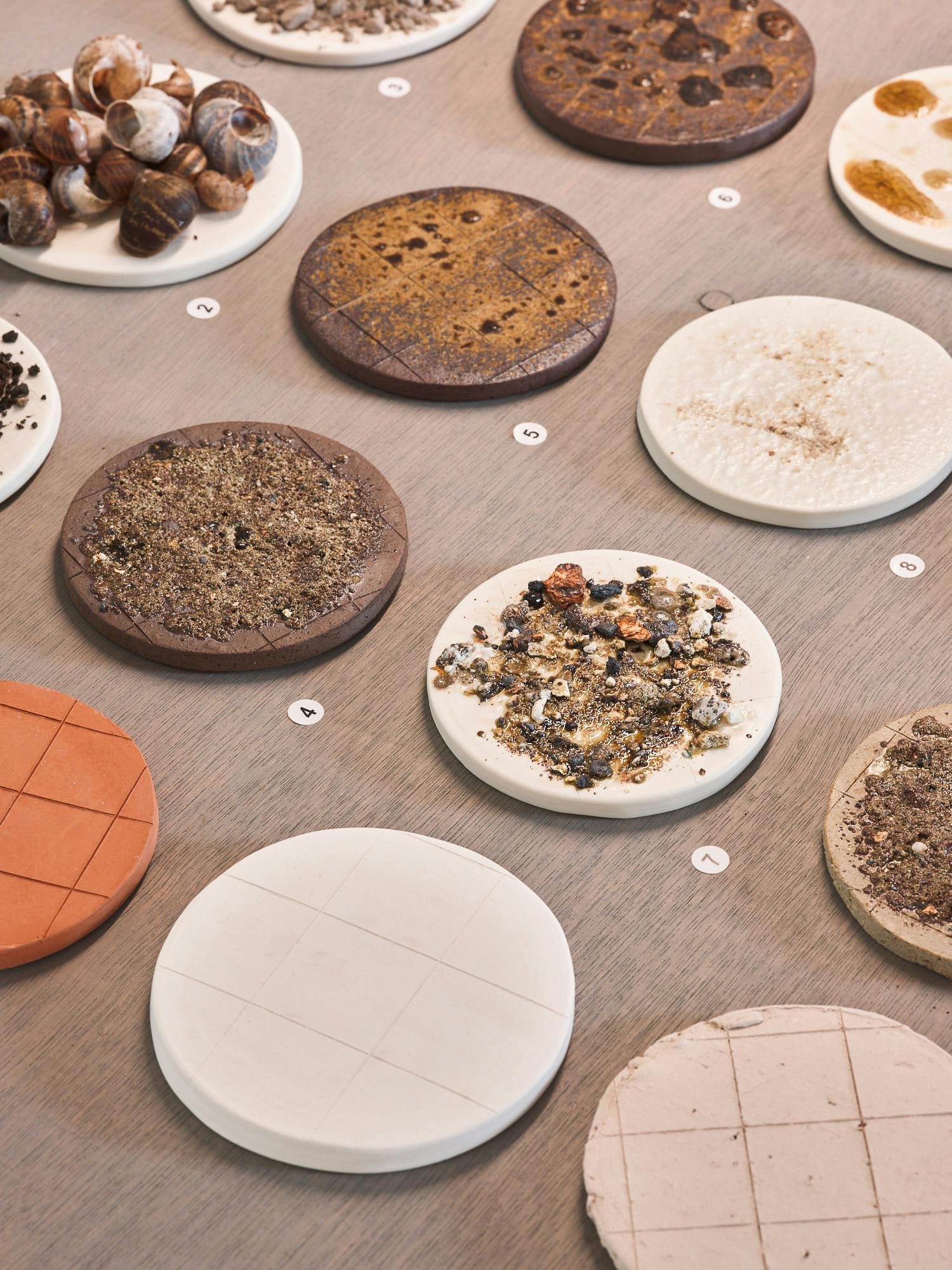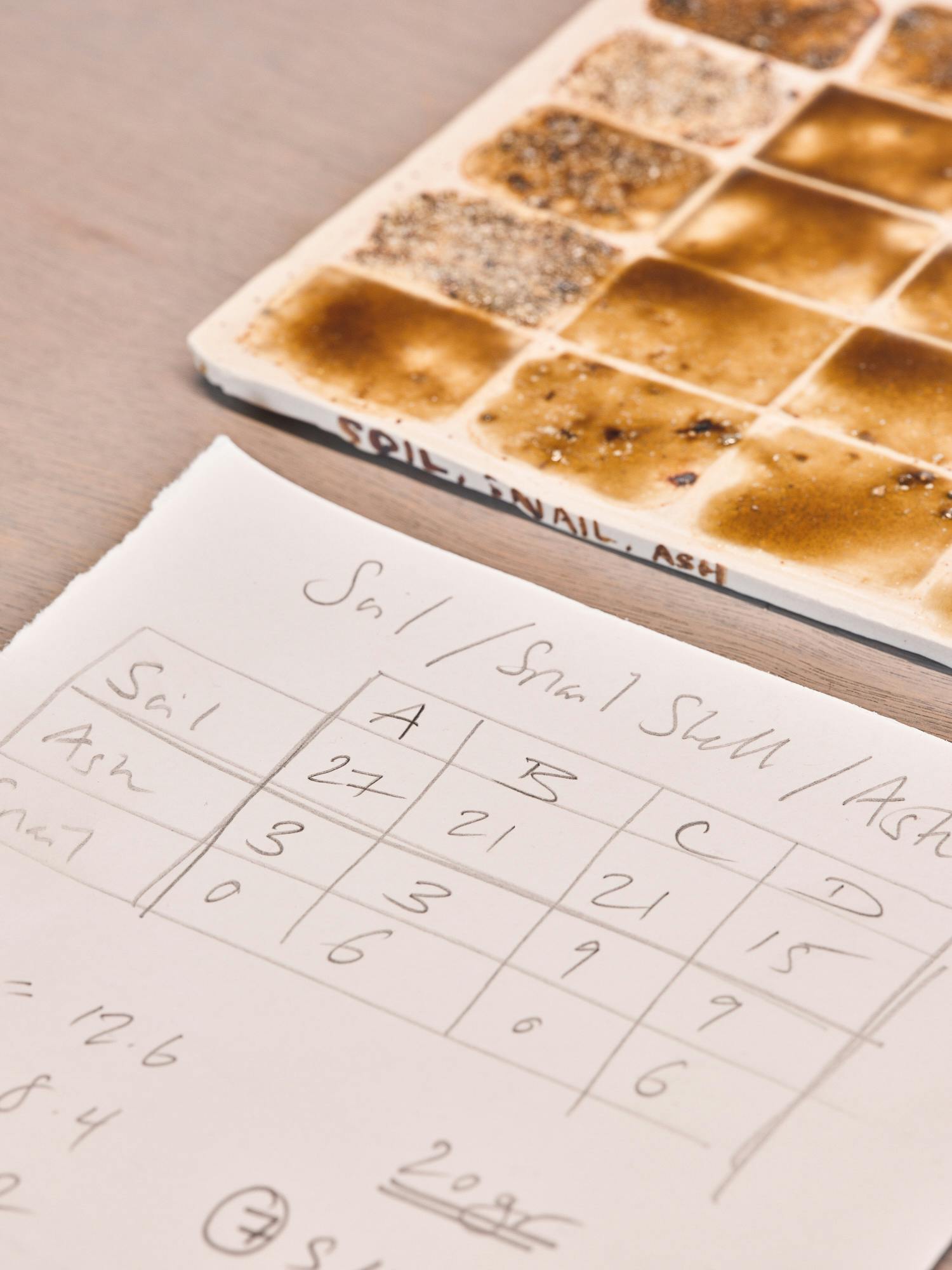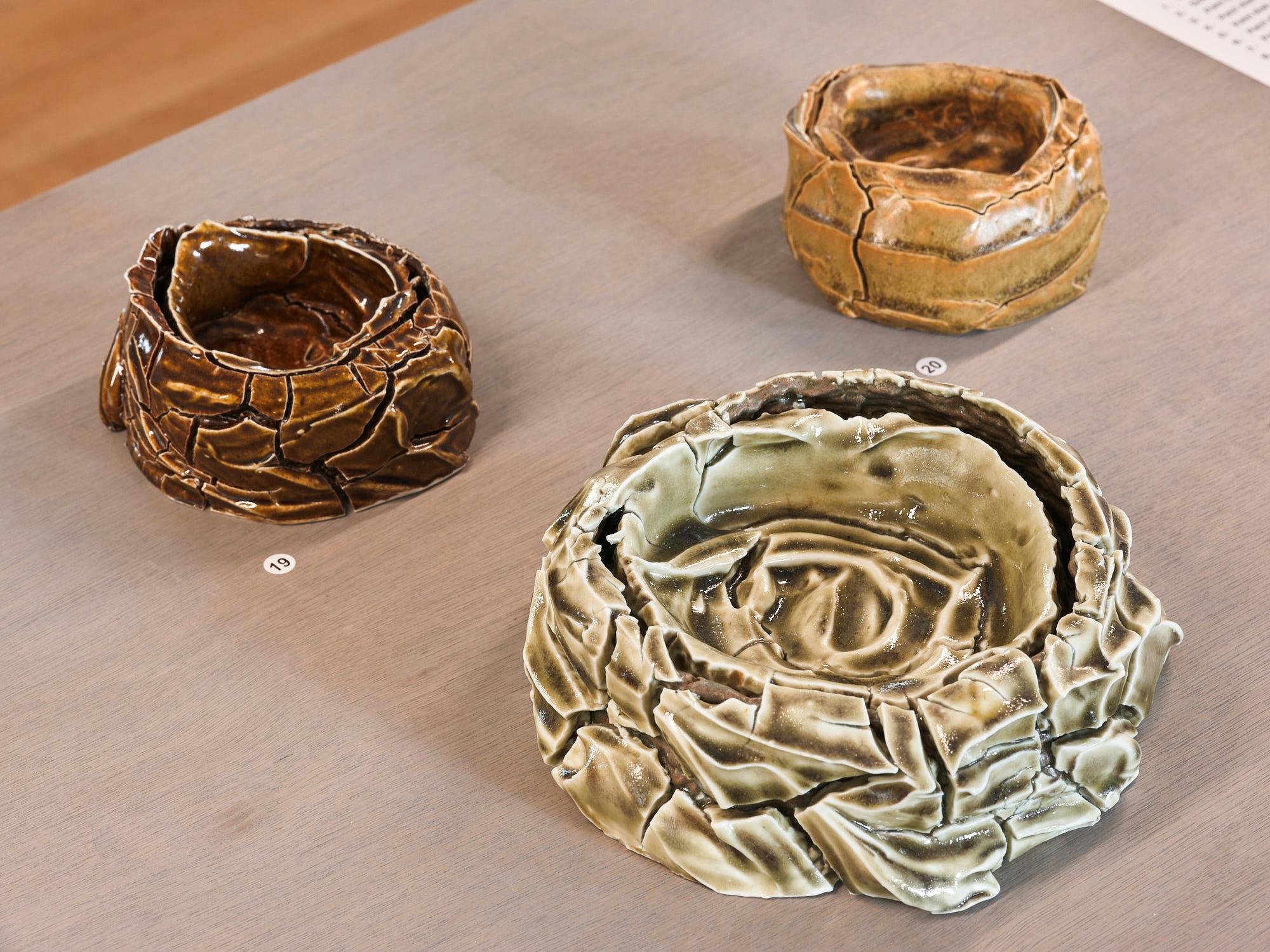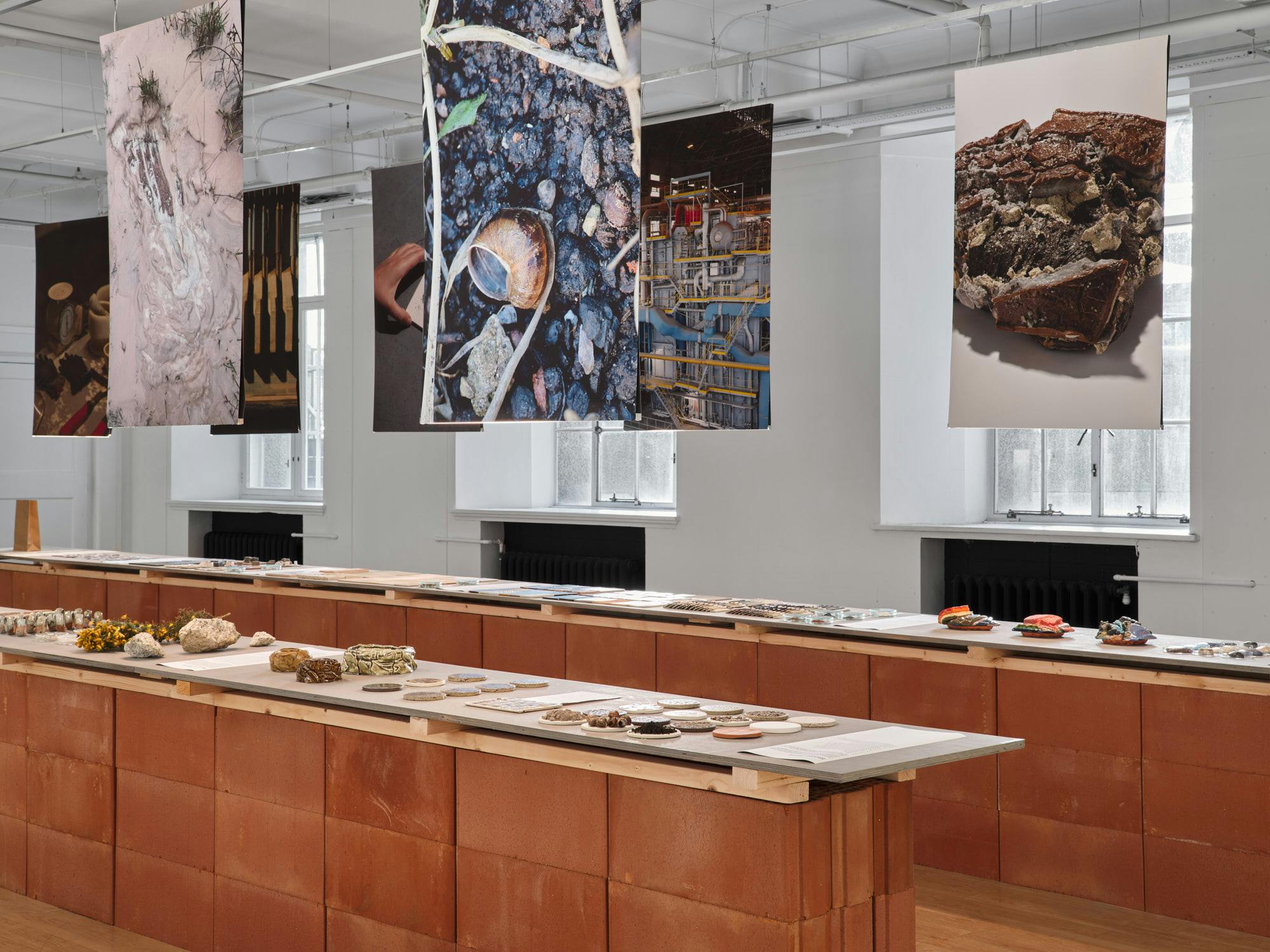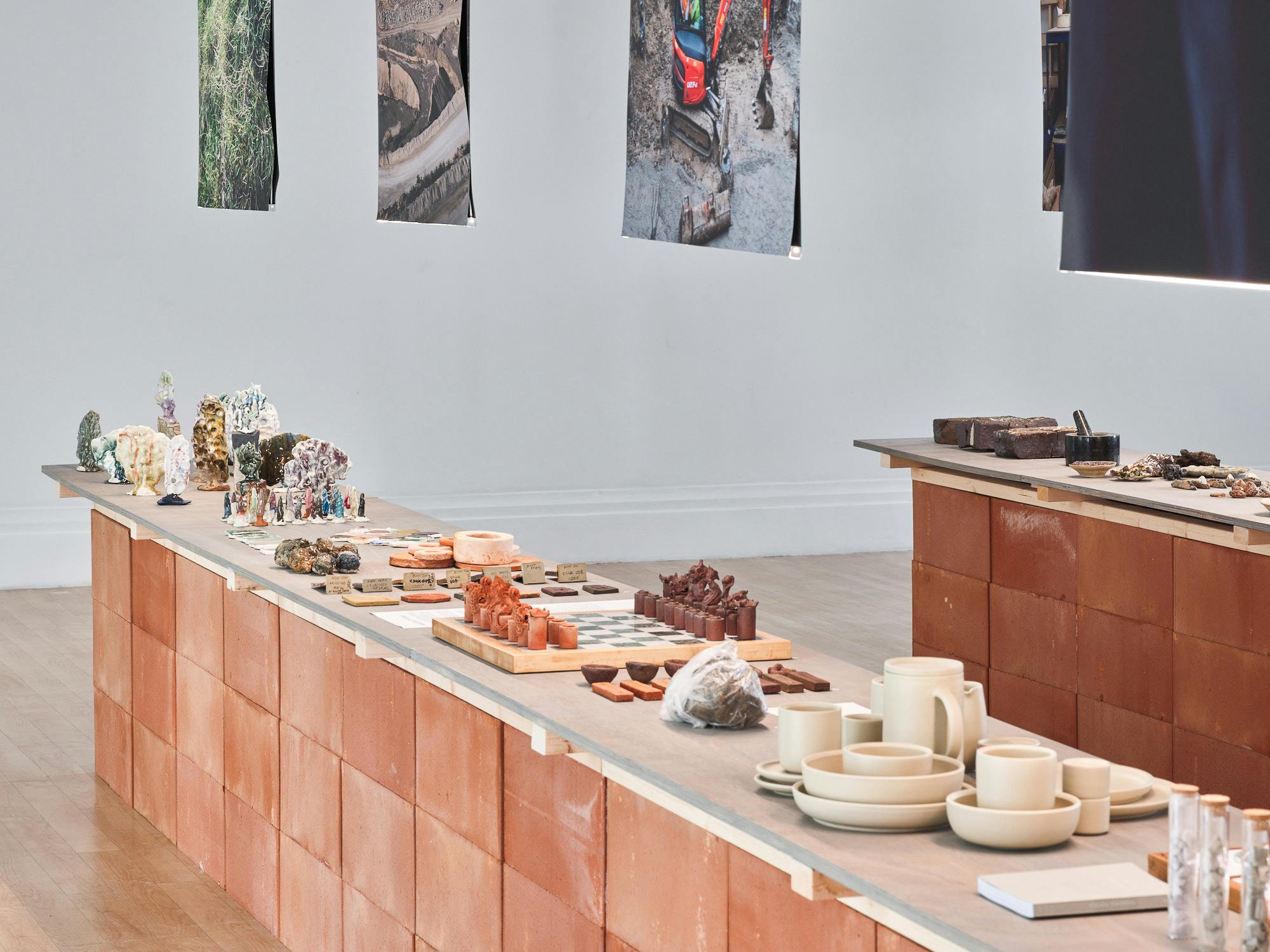
GROUNDWORKS
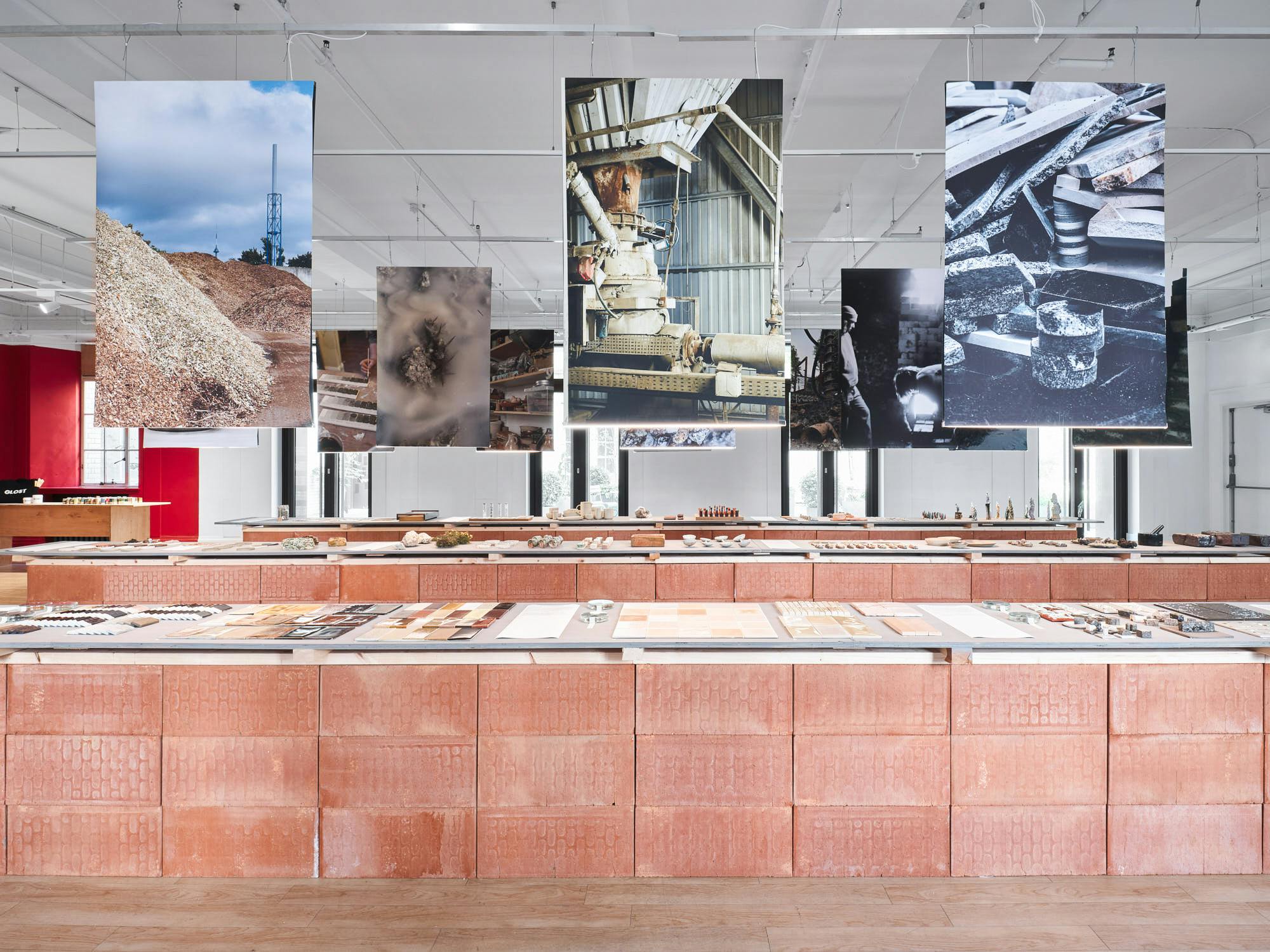
Born from GLOST glaze’s material research interviews and founder Elena Gileva’s decades-long investigation into ceramic materials, GROUND WORKS examines the fundamental relationship between raw materials and ceramic creation, offering visitors insight into the processes that shape contemporary sustainable practices. Glost glaze presents the journey from mineral to form, highlighting the crucial dialogue between scientific understanding and artistic expression through this exhibition.
Through a curated collection of melt tests, geological specimens, and infographics, visitors gain insight into the chemistry and methodology behind glaze making and material experimentation. The exhibition emphasizes process and research, showcasing how contemporary makers approach material testing and development in their practice.
Equal importance is placed on process and outcome. Through prototypes, test pieces, and works-in-progress, visitors gain understanding of the methodical journey of material investigation. The displayed work represents the rigorous process of research, testing, and refinement, offering transparency into ceramic development.
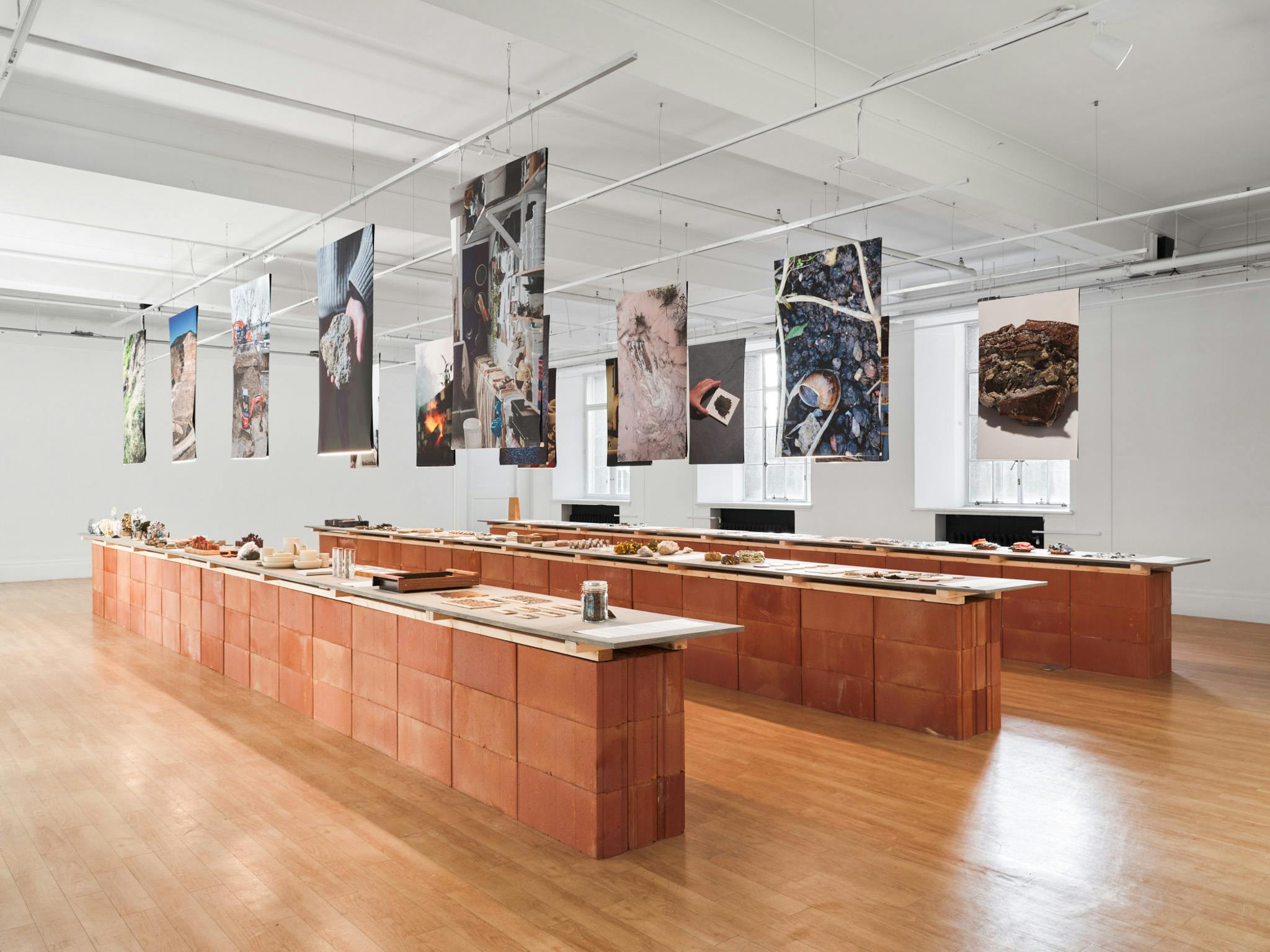

Featured works explore various approaches to material use, from systematic glaze testing to experimental material combinations. Some makers investigate the potential of local clay bodies and ash glazes, while others experiment with unconventional materials and processes. This diversity of approach demonstrates the breadth of possibility within ceramic material research.
Ground Works serves as both documentation of current ceramic innovation and an exploration of material possibilities. By examining the intersection of scientific inquiry, artistic practice, and material research, the exhibition reveals how contemporary ceramicists are developing new understanding of materials while considering their environmental impact.
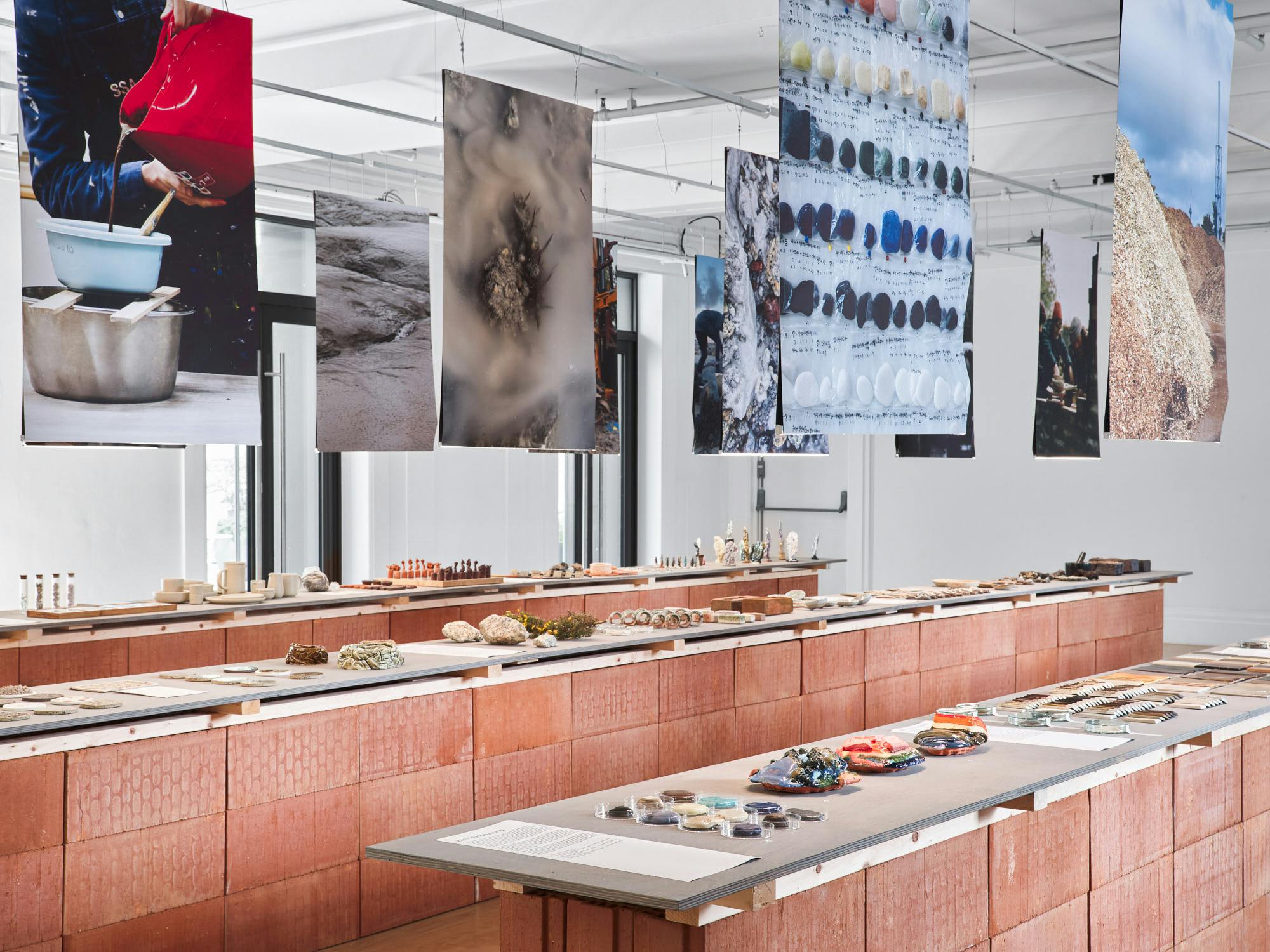
Agne Kucerenkaite
Metal Waste is Bliss
Metal Waste is Bliss reclaims industrial metal waste as pigments for sustainable ceramic surfaces. Initiated in 2016, the project began with research into metal residues from the drinking water supply and soil remediation industries, which generate thousands of tonnes of waste annually. These materials are repurposed to create glazes containing up to 40% waste content. By replacing newly mined metals and reducing chemical processing, the glazes offer an alternative to conventional ceramic practices. All colours are developed without the use of toxic lead and barium, and a redesigned palette launched in 2023 also replaces traditional calcium carbonate. Each colour derives solely from reclaimed industrial by-products, preserving both material character and environmental responsibility.
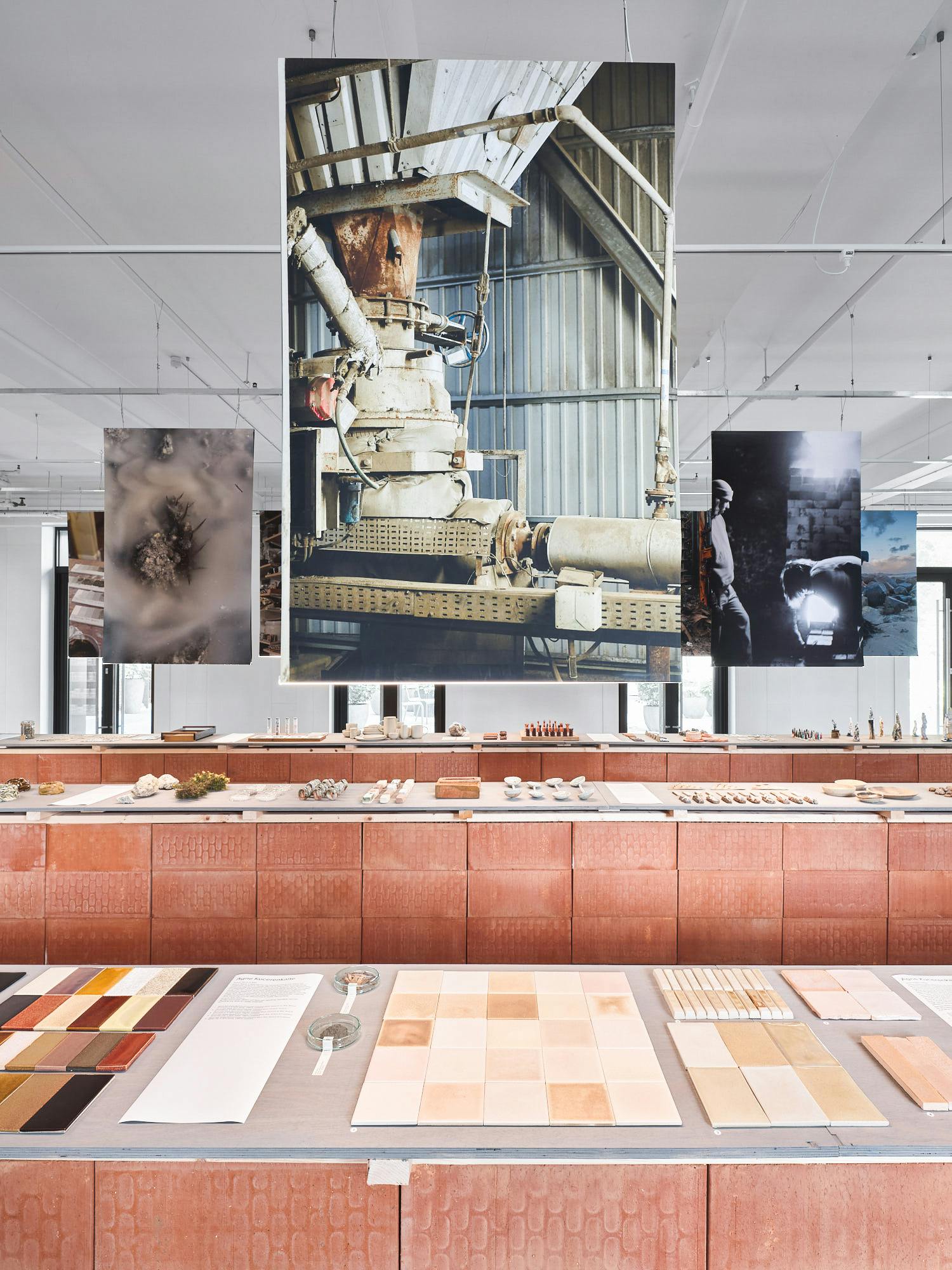
Iron Waste Pressing Machine at Vilniaus Vandenys, Drinking Water Supply Industry in Lithuania
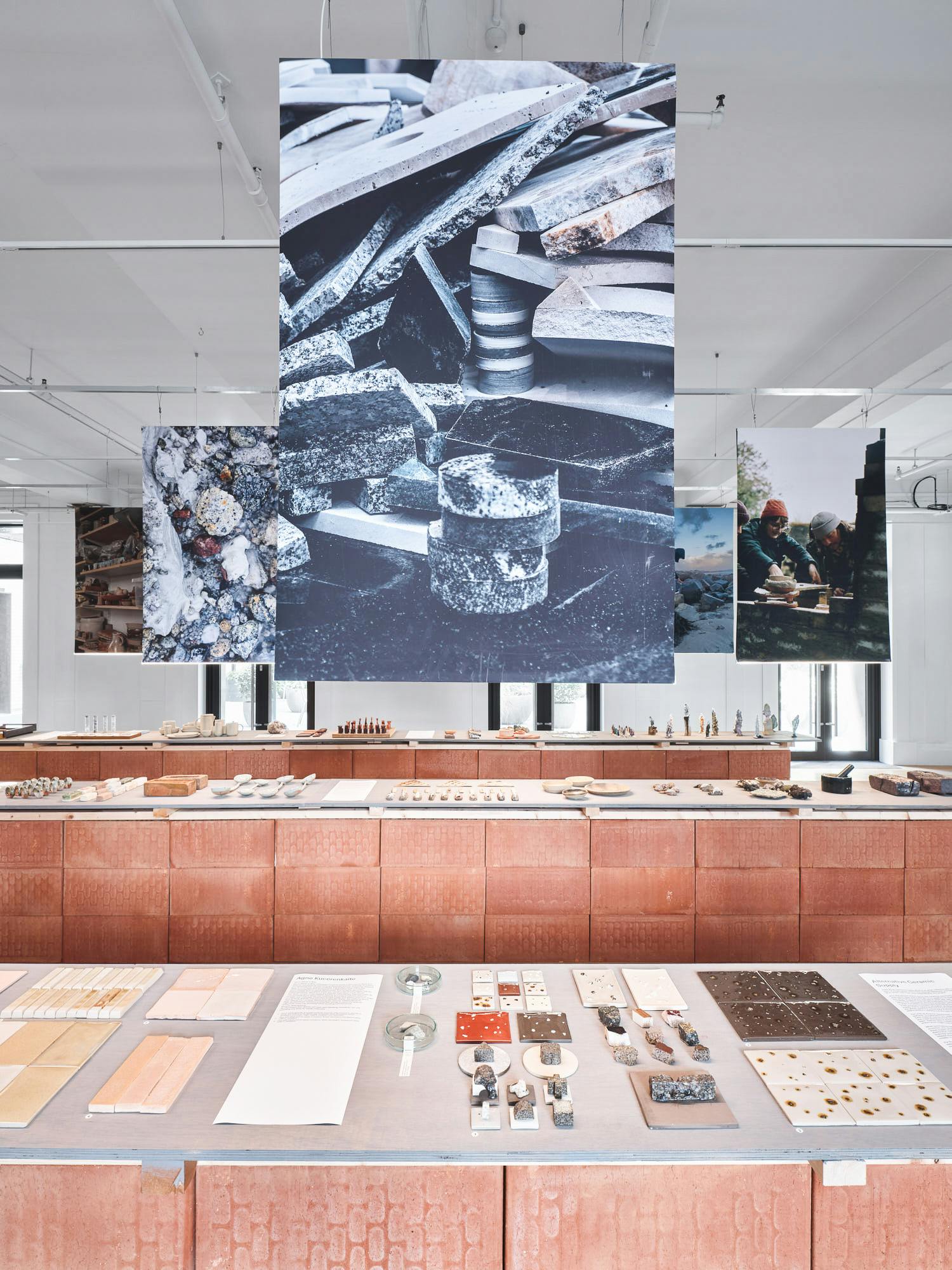
Natural Stone Waste from Akmenstata Company in Vilnius, Lithuania
Biofuel Waste is Bliss
Biofuel Waste is Bliss transforms industrial biofuel ash waste into sustainable ceramic surfaces, offering an alternative to conventional glazes and clay compositions. Developed by designer Agne Kucerenkaite in collaboration with environmental scientist Marija Spokaite, the project works with the Vilnius Heat Plant, which generates around 460 tonnes of wood ash waste per month, much of posing significant disposal challenges. By incorporating up to 55% ash into ceramic glazes and clay bodies, the project reduces the need for newly extracted raw materials while exploring circular approaches to waste repurposing.
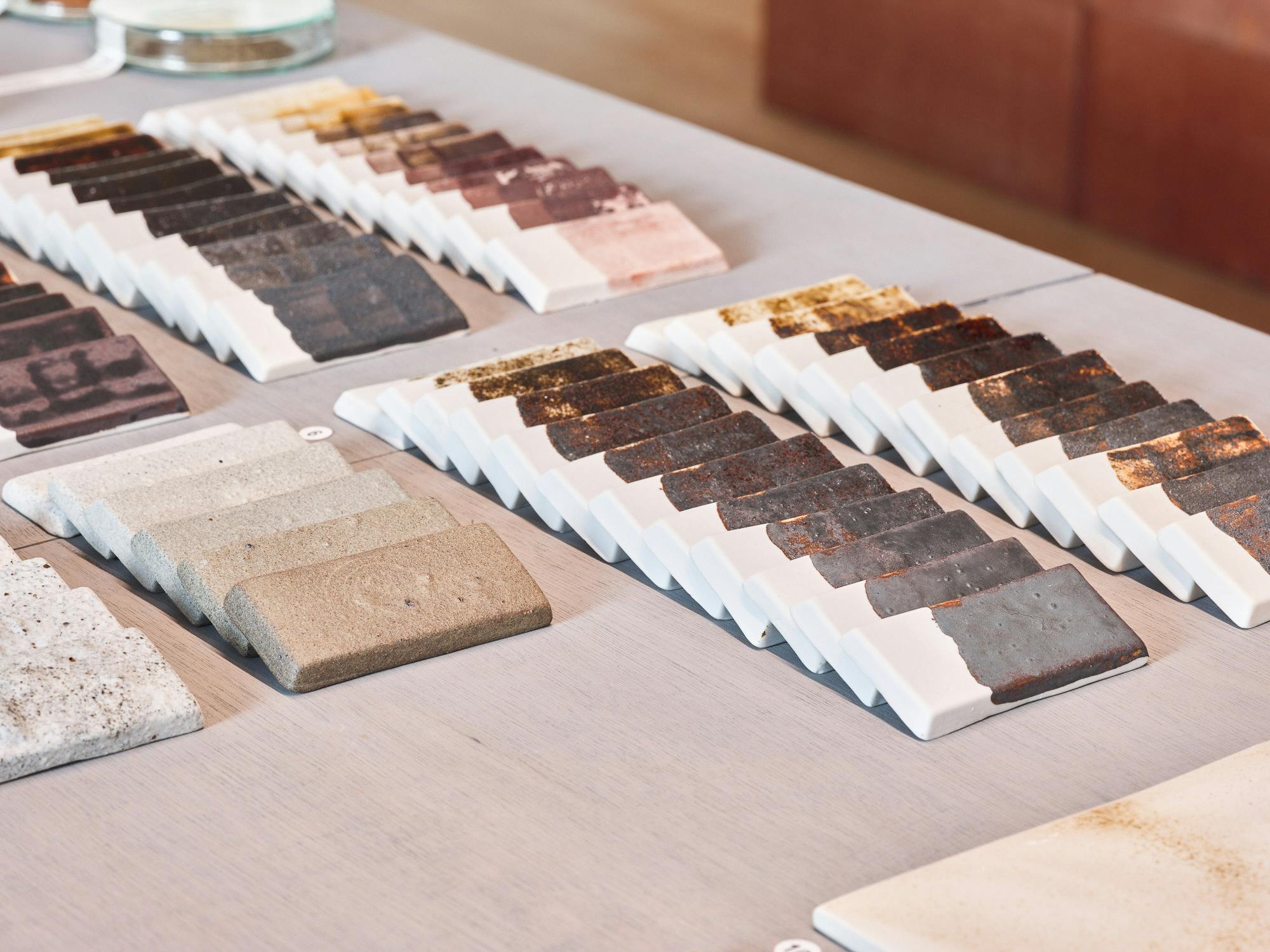
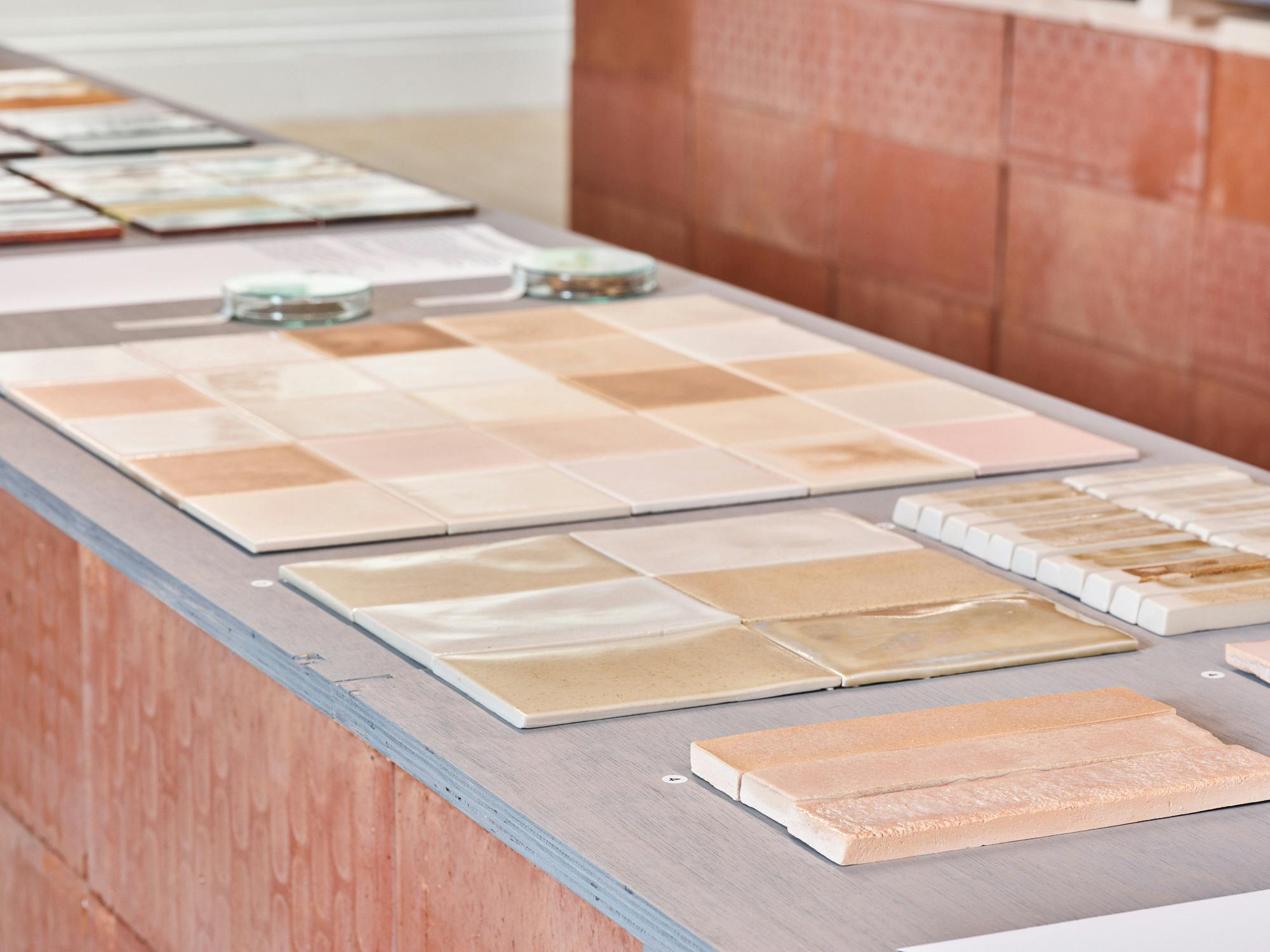
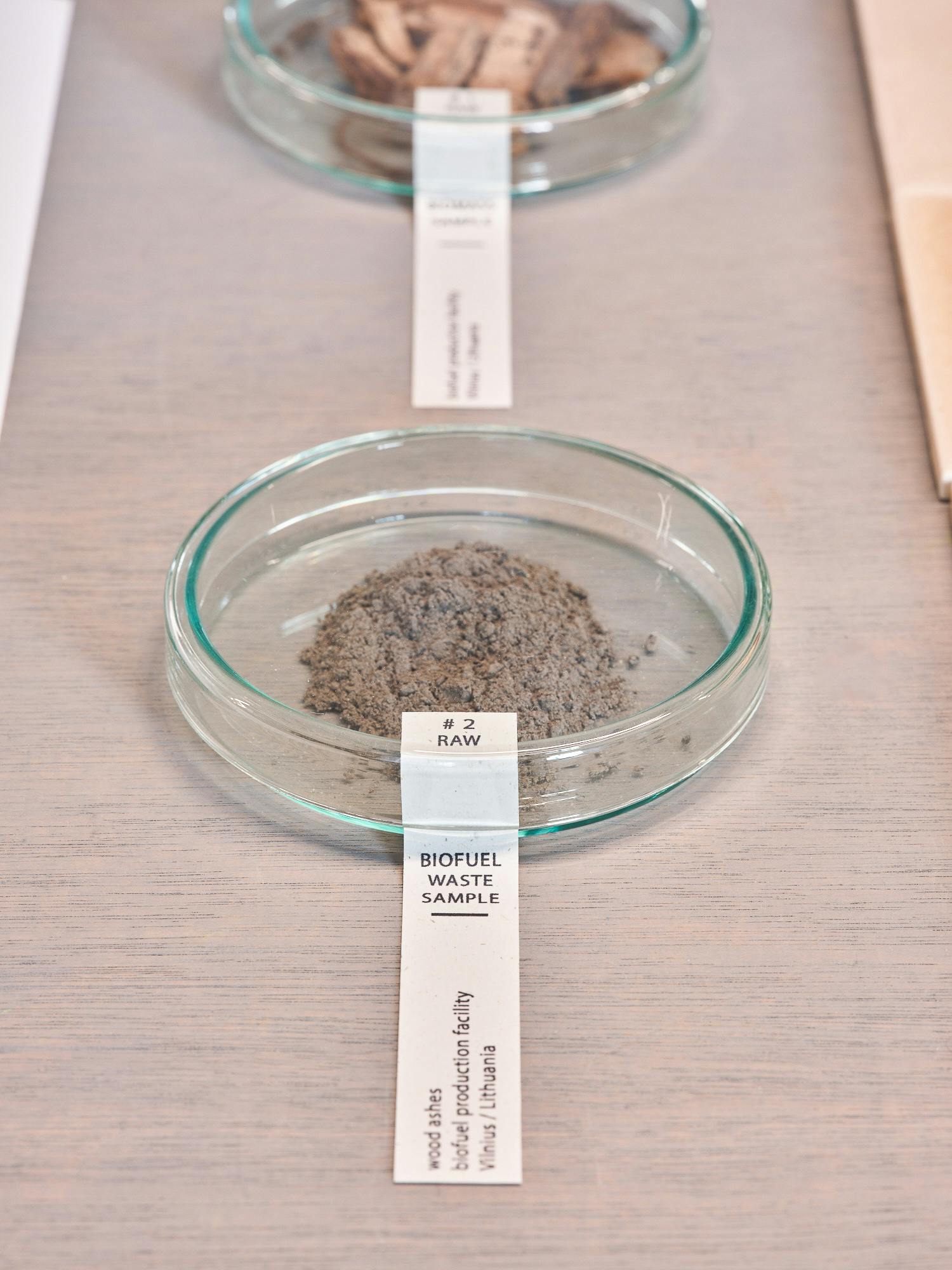
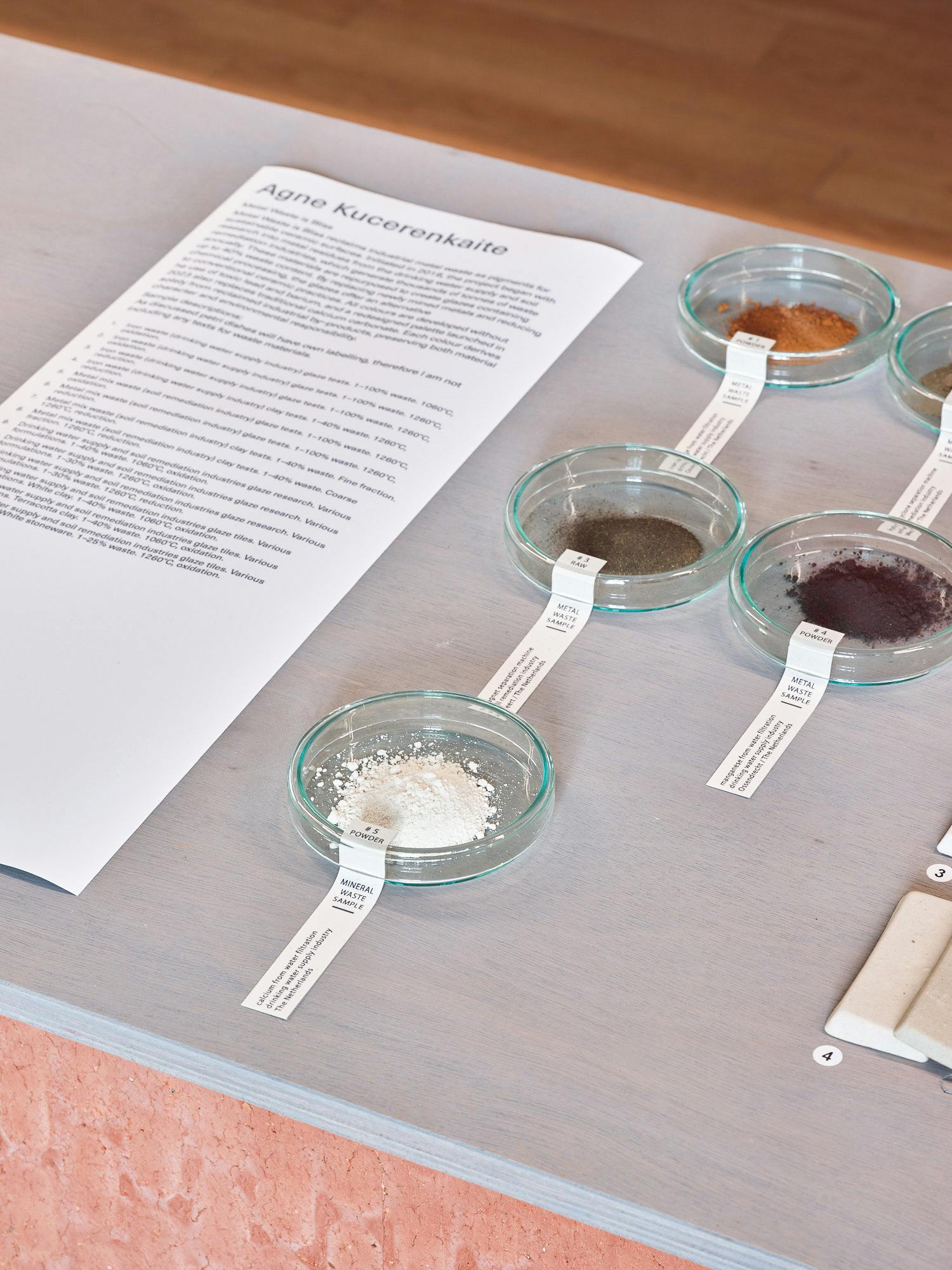
Stone Waste is Bliss
Stone Waste is Bliss addresses industrial waste in the natural stone and ceramic industries by repurposing discarded granite, quartzite, limestone, and travertine into ceramic surfaces. The project was initiated by designer Agne Kucerenkaite and developed in collaboration with Lithuanian stone-processing company Akmenstata. The company generates approximately 8m³ of stone waste per month in the form of edges, offcuts, and small pieces. While some are used for road fillers, most, though non-toxic, remain underutilised, leading to unnecessary disposal costs. By incorporating stone waste into ceramics, the project reduces reliance on virgin raw materials, minimises landfill waste, and lowers chemical usage. During firing, granite inclusions form delicate, flower-like patterns due to their natural iron content, eliminating the need for added pigments. High-temperature-resistant granite also bonds to ceramics without adhesives, ensuring durability while avoiding harmful glues.
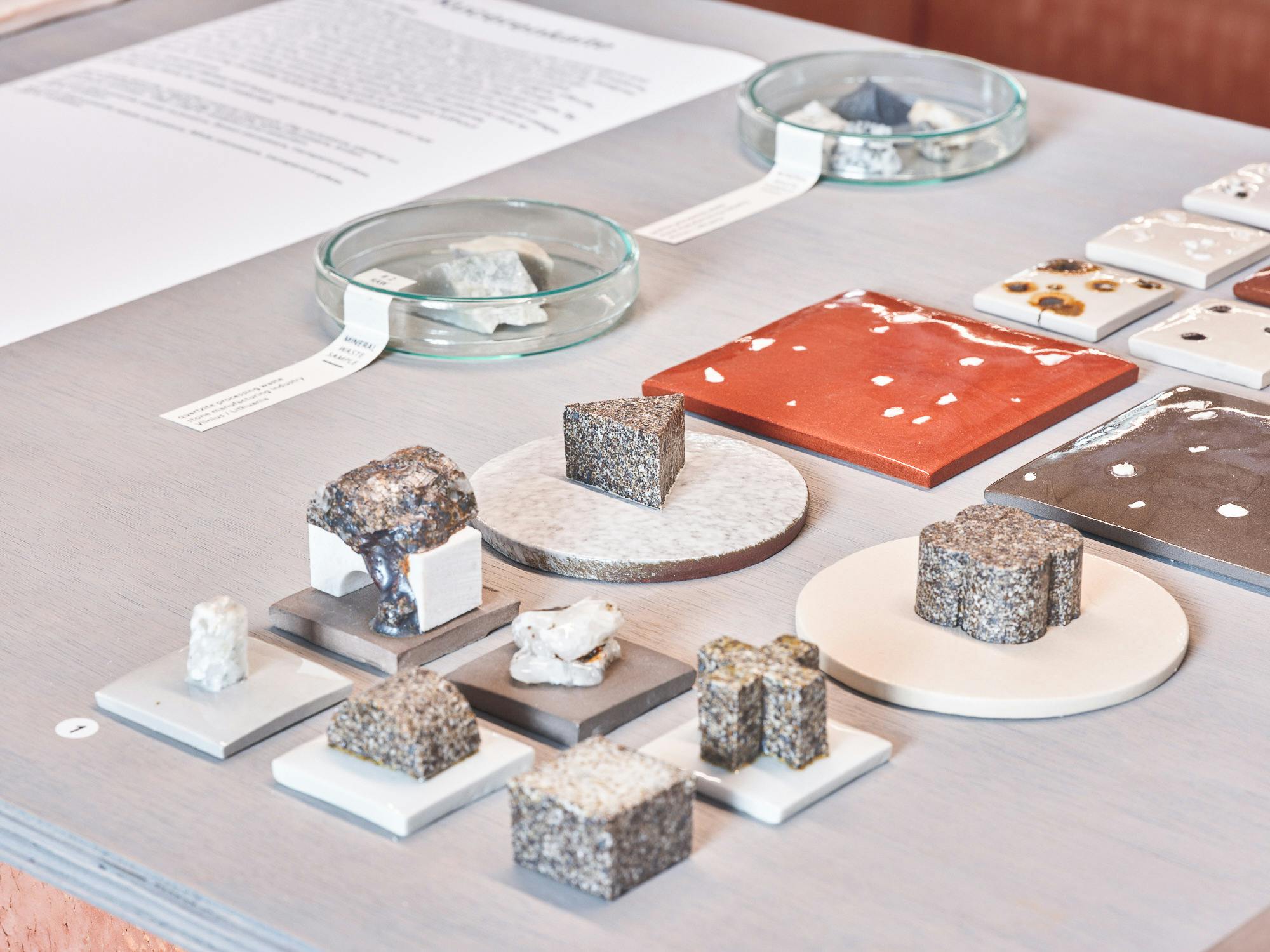
Alternative Ceramic Supply
Alternative Ceramics Supply (ACS) is an artist collective with a founding team of Amelia Black, Claire Ellis, Georgia Stevenson and Sarah Muir-Smith with fluid roles depending on the project.
ACS disrupts the status quo in the ceramics community by exploring alternative ideas and materials. It is a platform to challenge the assumption that the only way to work with clay is to use mined minerals. Together, they are advocating for the custodianship of materials rather than ownership, aiming to empower potters to look at the materials in their immediate environment (including local urban waste streams). Their purpose is to foster education, empowerment, transparency in supply chains, safety, and community building within the global ceramics community. Environmental, cultural and social responsibility in pottery is at the core of what they do.
Part pop-up shop for ceramicists, part interactive exhibit, Bulk Buy featured 10 materials from ‘waste’ streams and industry by-products. Each material was sourced locally, processed on a small scale and made available for purchase by the Alternative Ceramics Supply team. Visitors were invited to wonder what a pottery supplies shop of the future might look like.
When purchasing raw materials from a pottery supply store in many countries, one receives very limited information about the material. Often, these supply chains are unclear or obfuscated, as some global distribution networks and mineral manufacturers have structured their business practices to exploit cheap labour and take advantage of more relaxed environmental and human protections for workers in low and middle-income countries.
For Bulk Buy, every material was sourced and processed locally. Material research was open source and available to all attendees based on their most recent link in the supply chain.
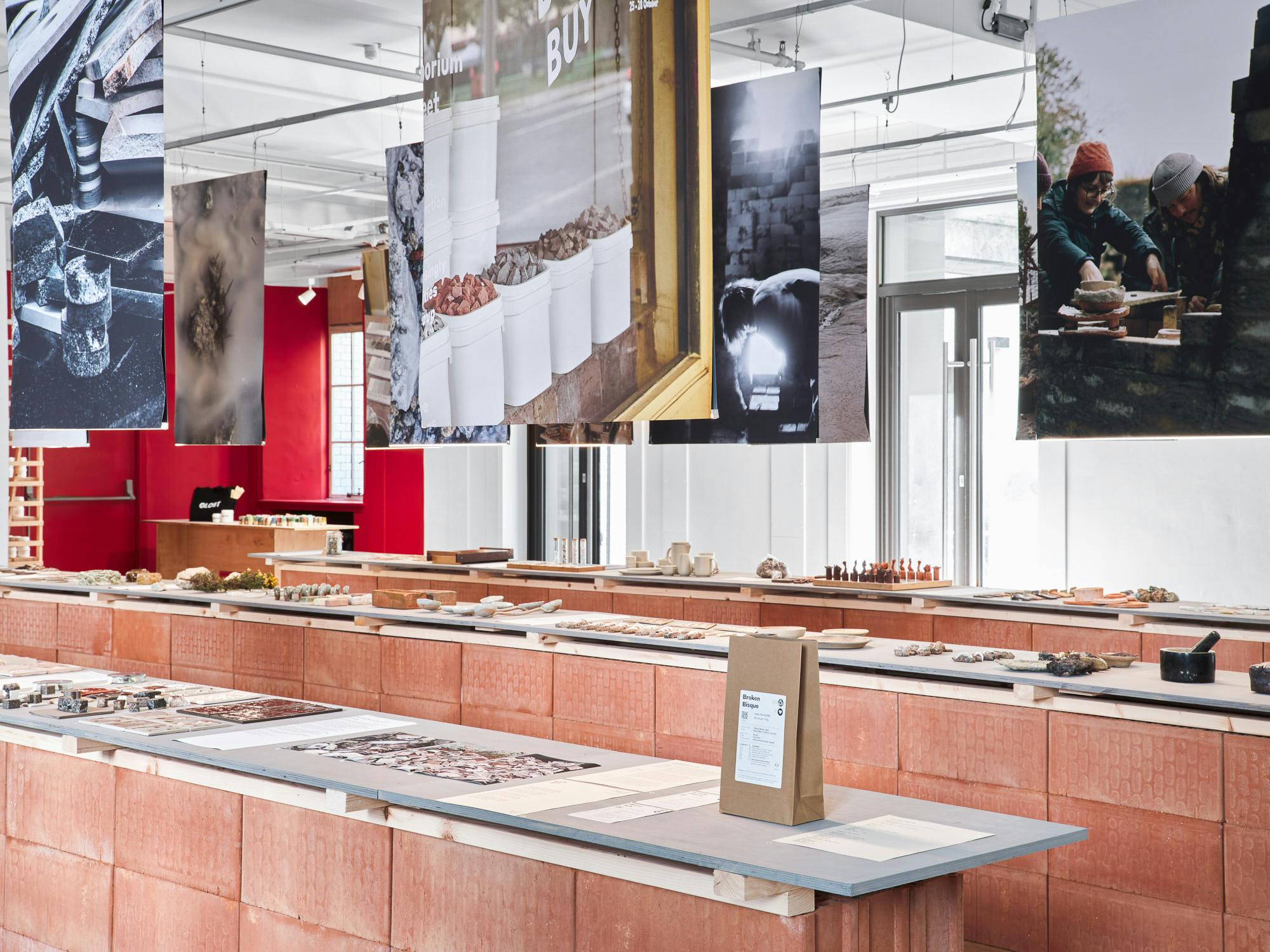
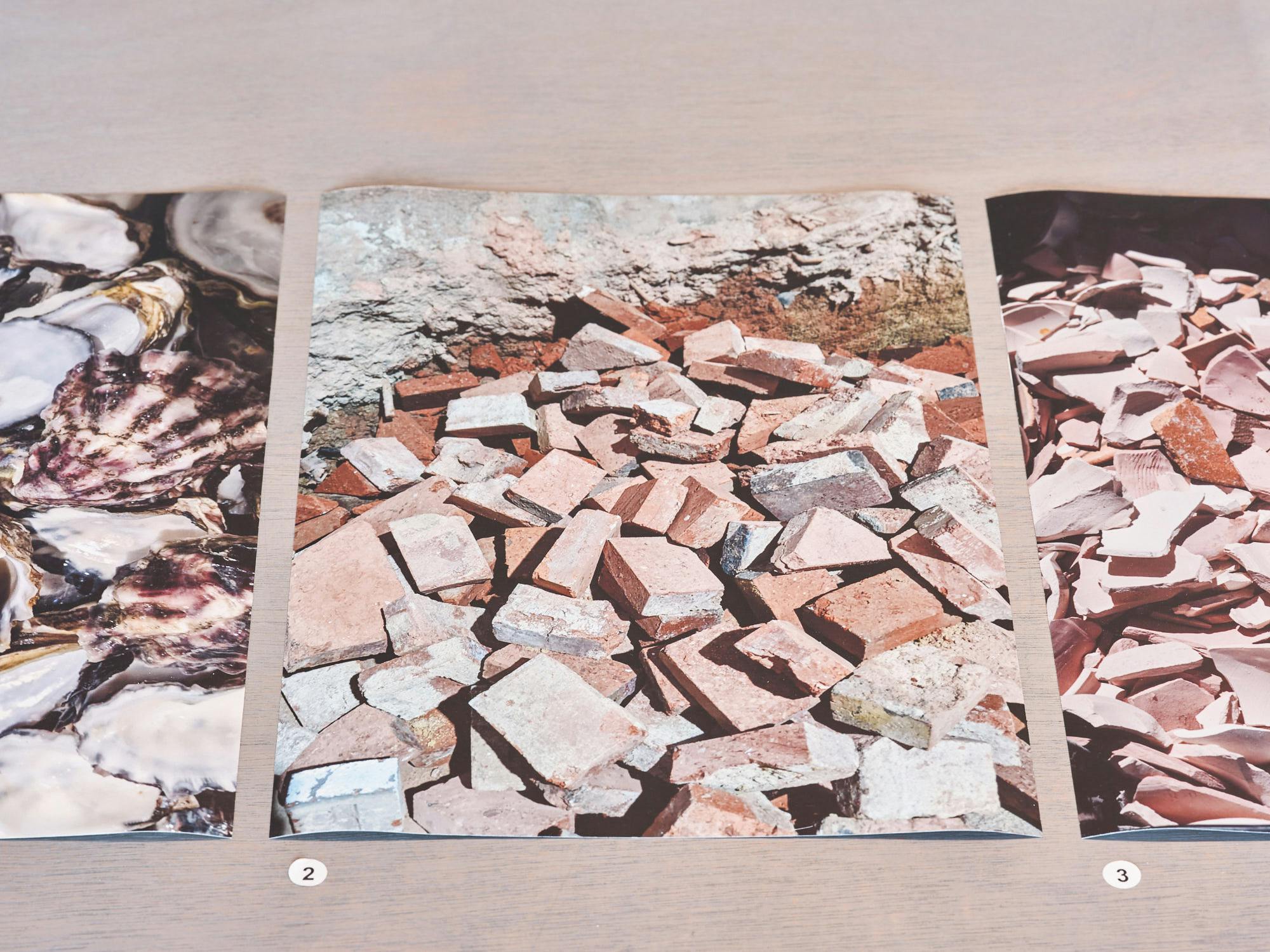
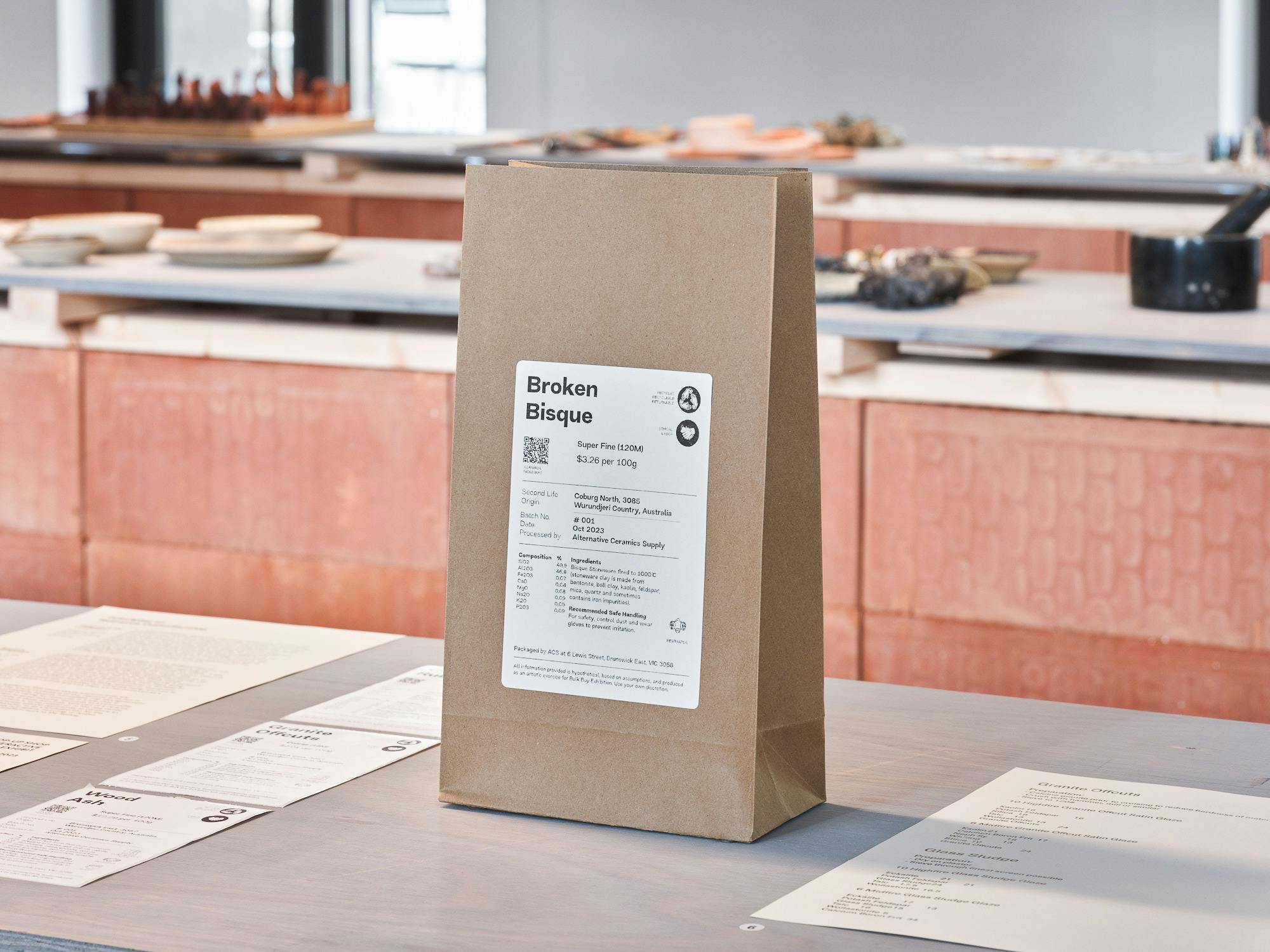
Kim Hyeonyoung
This work explores how materials behave under transformation and questions the way we perceive and name the world around us. Before shaping a final piece, the artist conducts experiments by mixing minerals and oxides and observing how these materials react during the firing process. Through this, she investigates how much a material can retain an intended form, or deviate from it, revealing unexpected colours and textures. These surprising results often feel alive, as though the material is asserting its own will, offering the artist moments of wonder and joy.
The piece is inspired by the phenomenon of rainbows, which are commonly imagined as seven-coloured arcs. In reality, however, a rainbow is a continuous, circular spectrum. This discrepancy led the artist to reflect on how language and categorisation can distance us from a deeper understanding of things. Just as a rainbow is more than what we’re taught to see, objects in our lives may hold more than what their names suggest.
By recognising that everything is made of ever-shifting elements, the artist sees form not as fixed, but as a temporary state of matter. This realisation fosters a sense of humility and connection to a larger cosmic order. In this work, she invites viewers to consider: What lies beyond what we think we know? And in this vast, shifting world what else might we become?
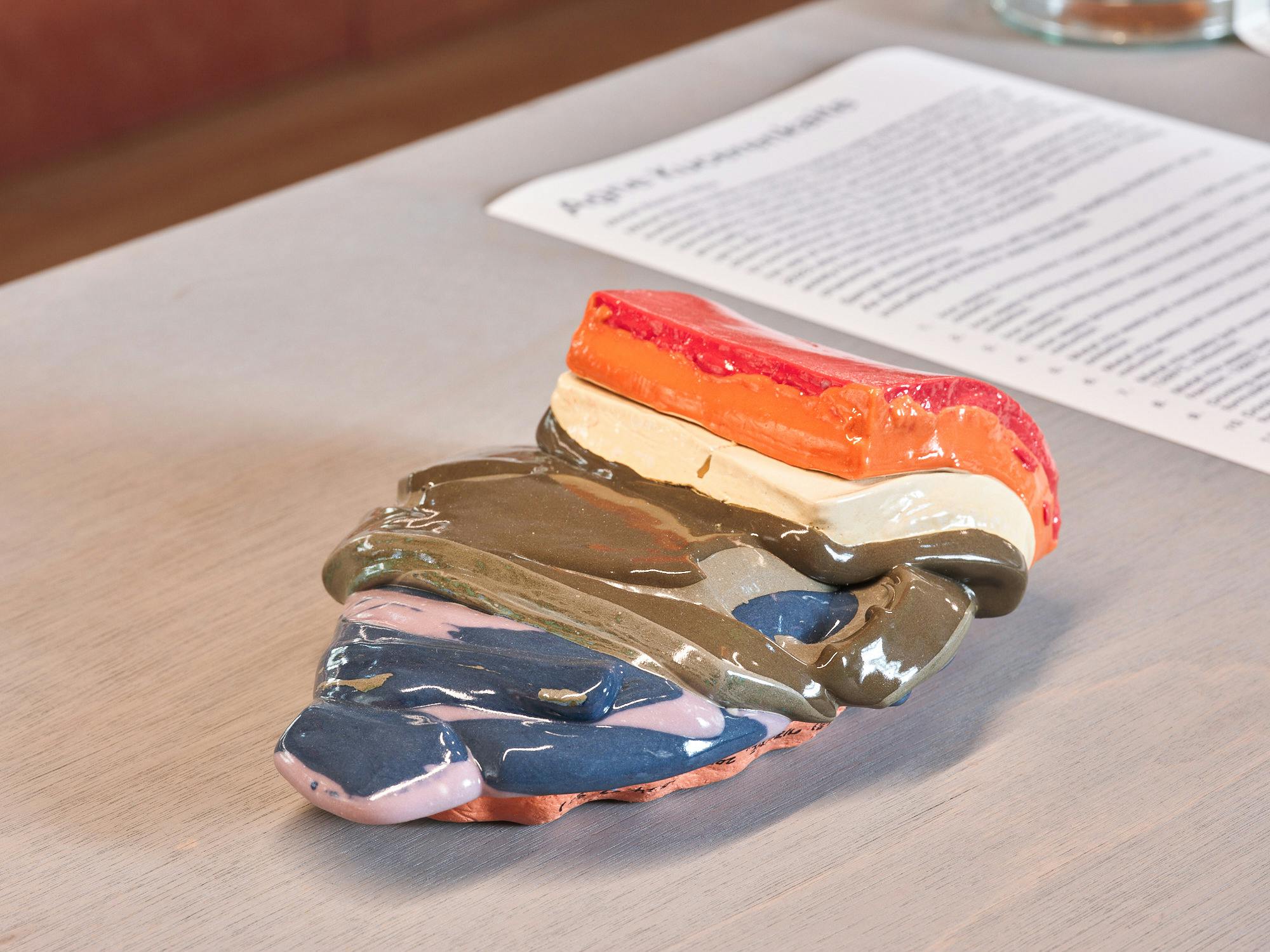
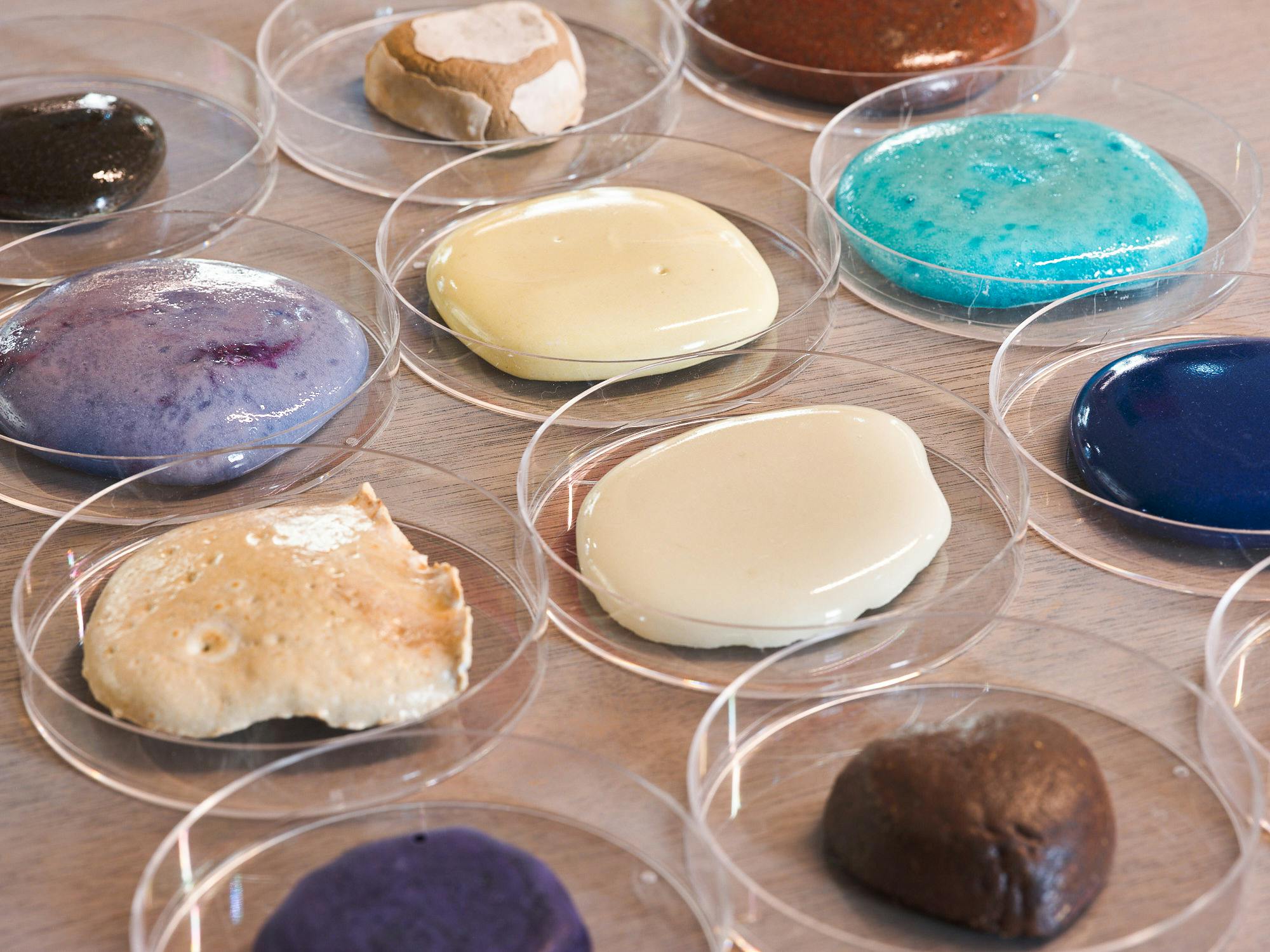
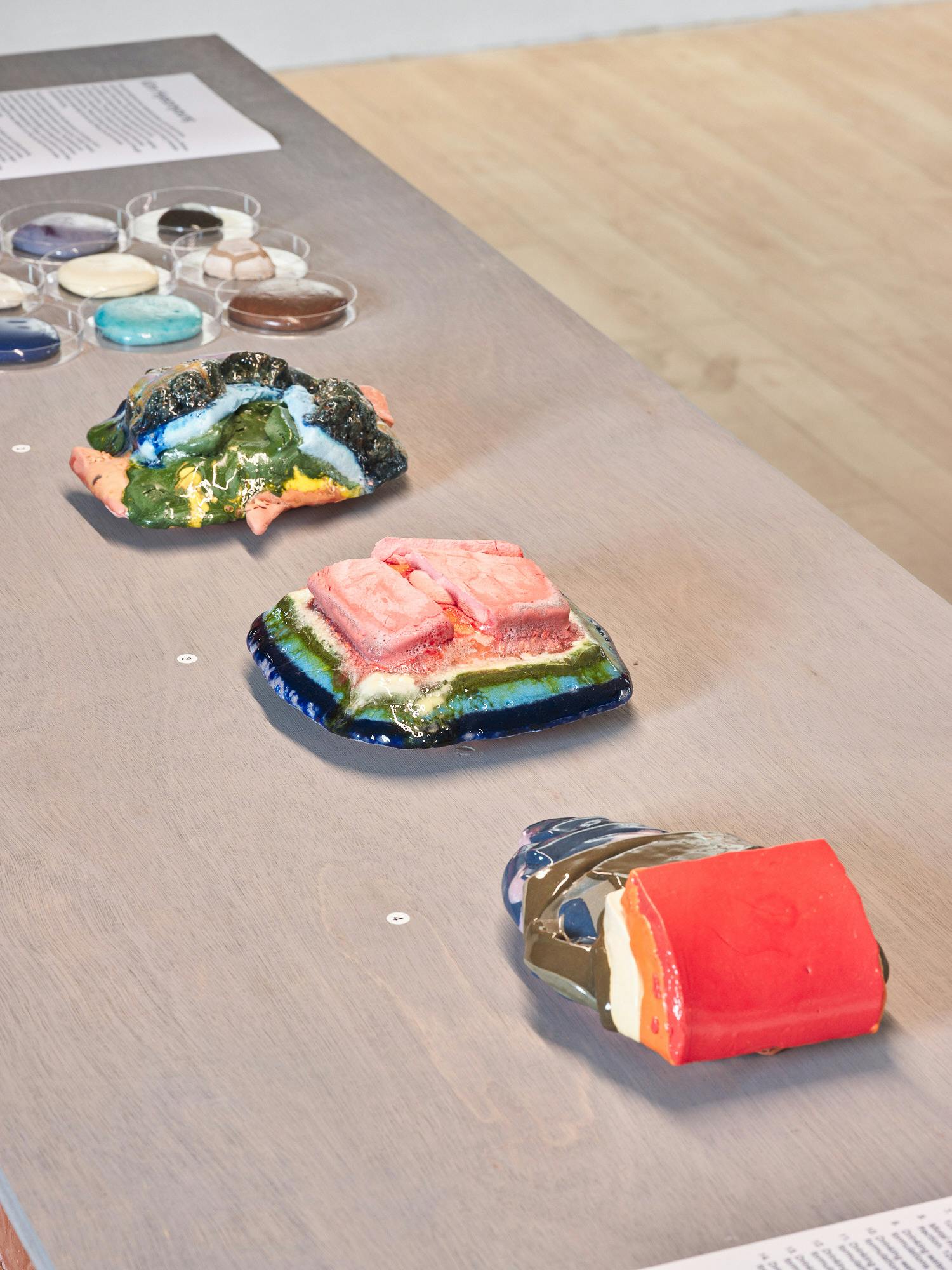
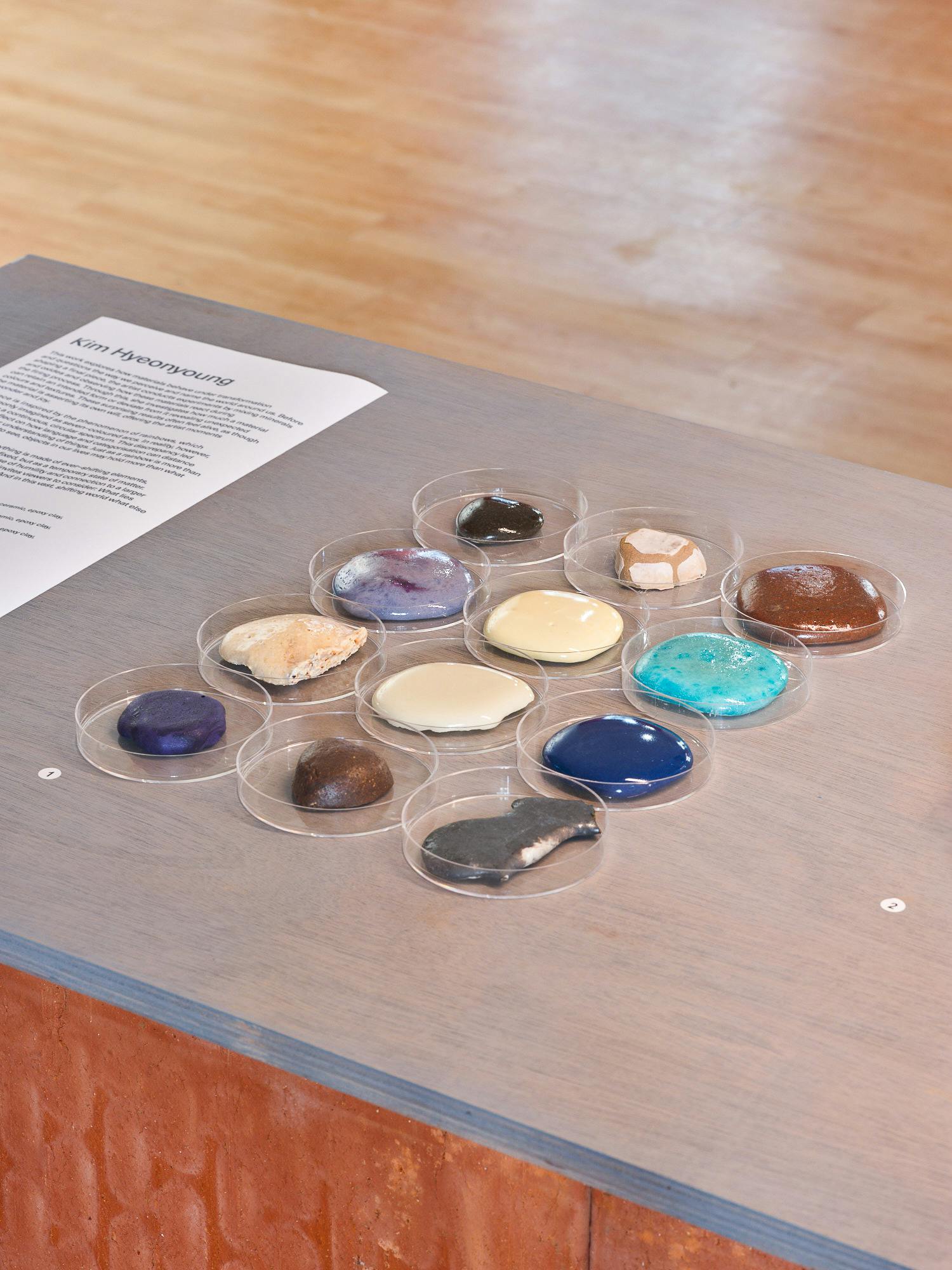
Julia Ellen Lancaster
Julia Ellen Lancaster is a UK based artist whose work often engages with imagined landscapes and speculative futures, exploring possible outcomes of our failure to respond to ecological collapse. Her practice is grounded in material research, investigating the histories, behaviours, and potentials of clay. By treating materials not just as media but as active collaborators, Lancaster uncovers how they can convey environmental narratives and socio-ecological critique.
Some works reference fossilised remains of extinct species, suggesting a future where what is familiar to us now exists only as memory. Others take inspiration from regenerative forms mimicking trees, coral reefs, fungal networks, or bioadaptive architecture to propose a world where nature and human structures coexist harmoniously.
Through these visual narratives, her work synthesises artistic inquiry, environmental consciousness, and a degree of scientific reflection, employing process driven experimentation and conceptual inquiry to provoke contemplation regarding injustices and environmental issues. Her practice critically examines the dynamic relationship between humanity and the natural world, emphasising ceramics' unique capacity to bridge past and present.
In the Coral Trees series, an ongoing body of work, Lancaster uses unwanted, leftover, and reclaimed clay and recycled glazes. Here, material research becomes central, as she allows the intrinsic qualities of the clay to emerge with minimal intervention, letting the clay respond naturally to the force of her hand.
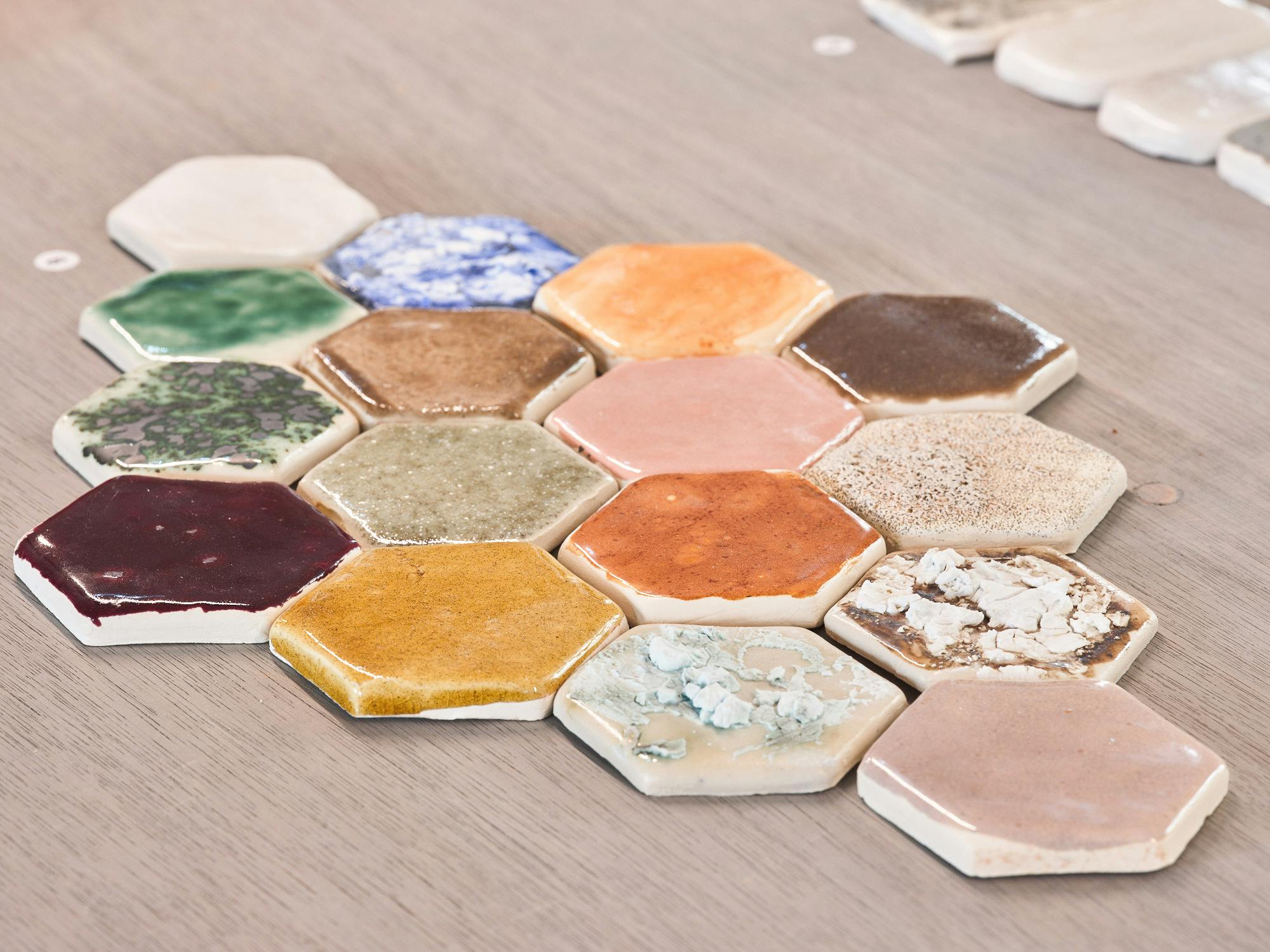
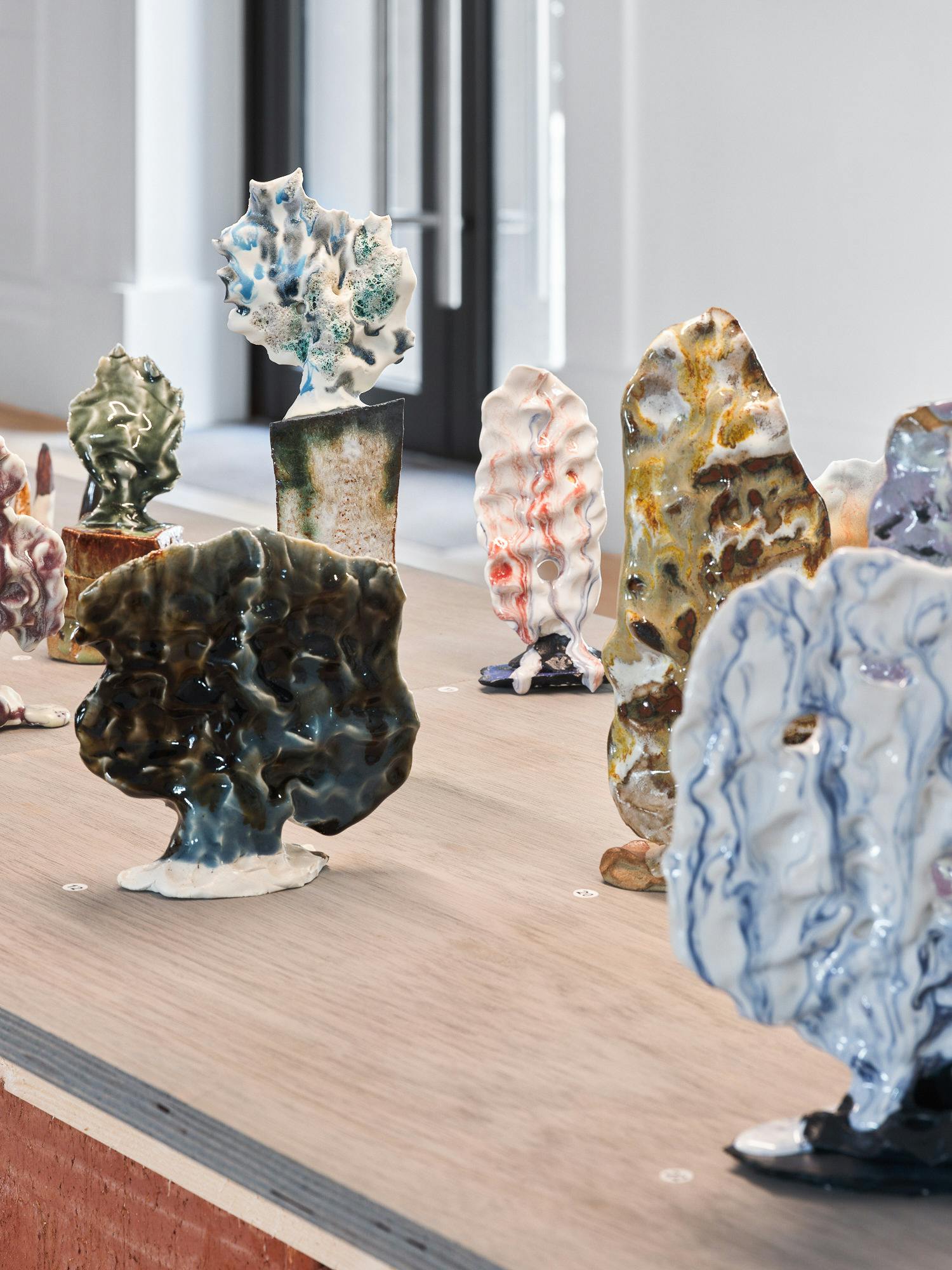
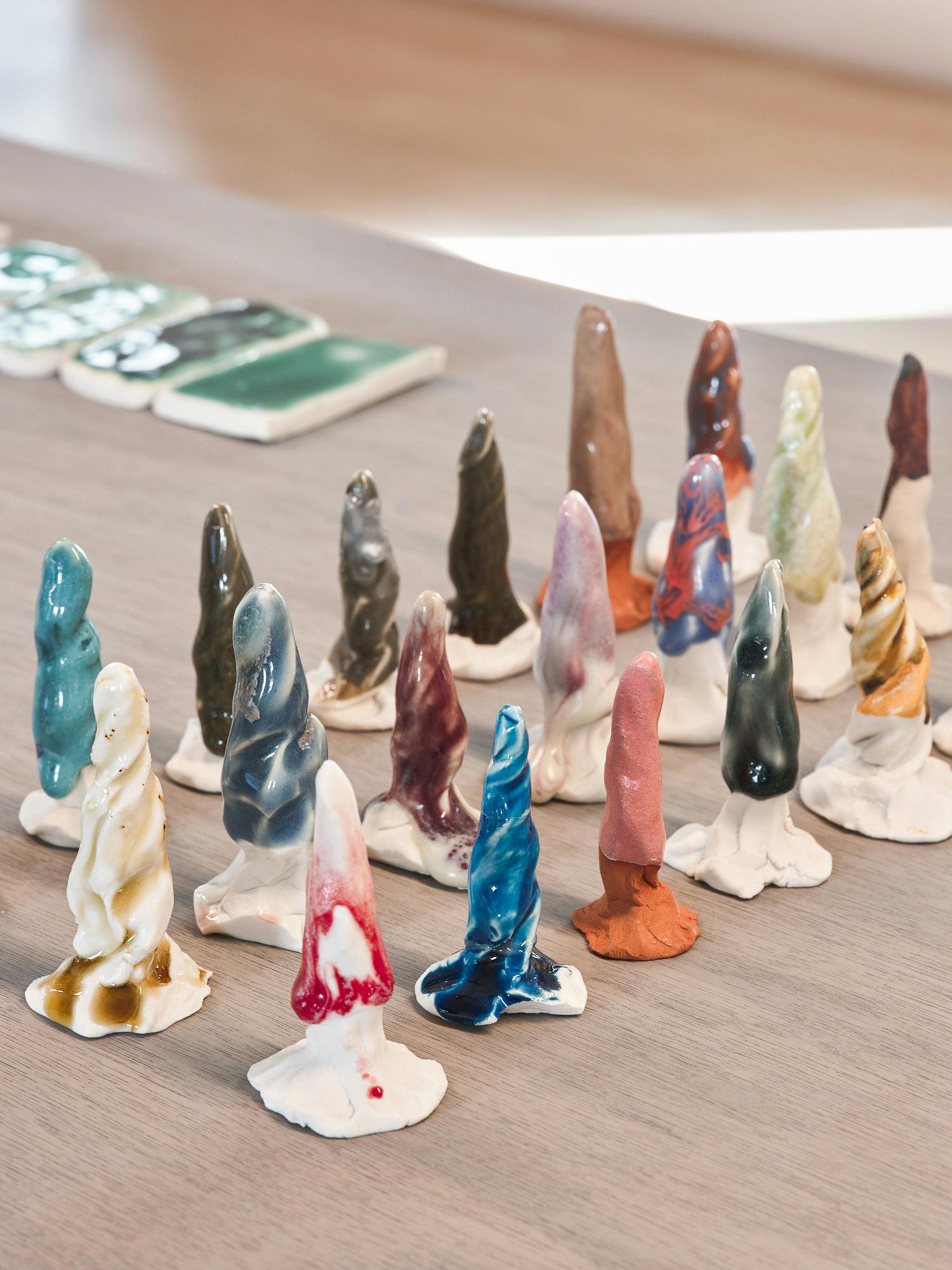

Natalia Kasprzycka
Erith Tile
The Erith Tile was made by many hands. It began its life as part of the Arts Council England-funded Constructivist Commission series at the Exchange, supporting the continued fit-out of the Old Library in Erith through community production and collaborations with designers and makers. Between 2022 and early 2024, Natalia Kasprzycka and the Exchange community worked together to produce ceramic tiles, now fitted in the building, using local clay as the primary glaze ingredient.
With the Exchange’s proximity to the Thames, the river was quickly identified as an important resource. Together, the team dug the alluvium and refined it with a series of tools made in the Exchange’s wood workshop specifically for this process. The testing required to turn the material into a functional glaze took ten months, encompassing public workshops, consultations, studio research, and many conversations about local geology, history, and craft. Once the prototype was developed, volunteers took over production under the guidance of ceramics workshop manager and artist Ho Lai. In the winter of 2024, the tiles were installed in the Garden Room at the Old Library and are currently part of a developing series of furniture at the Exchange.
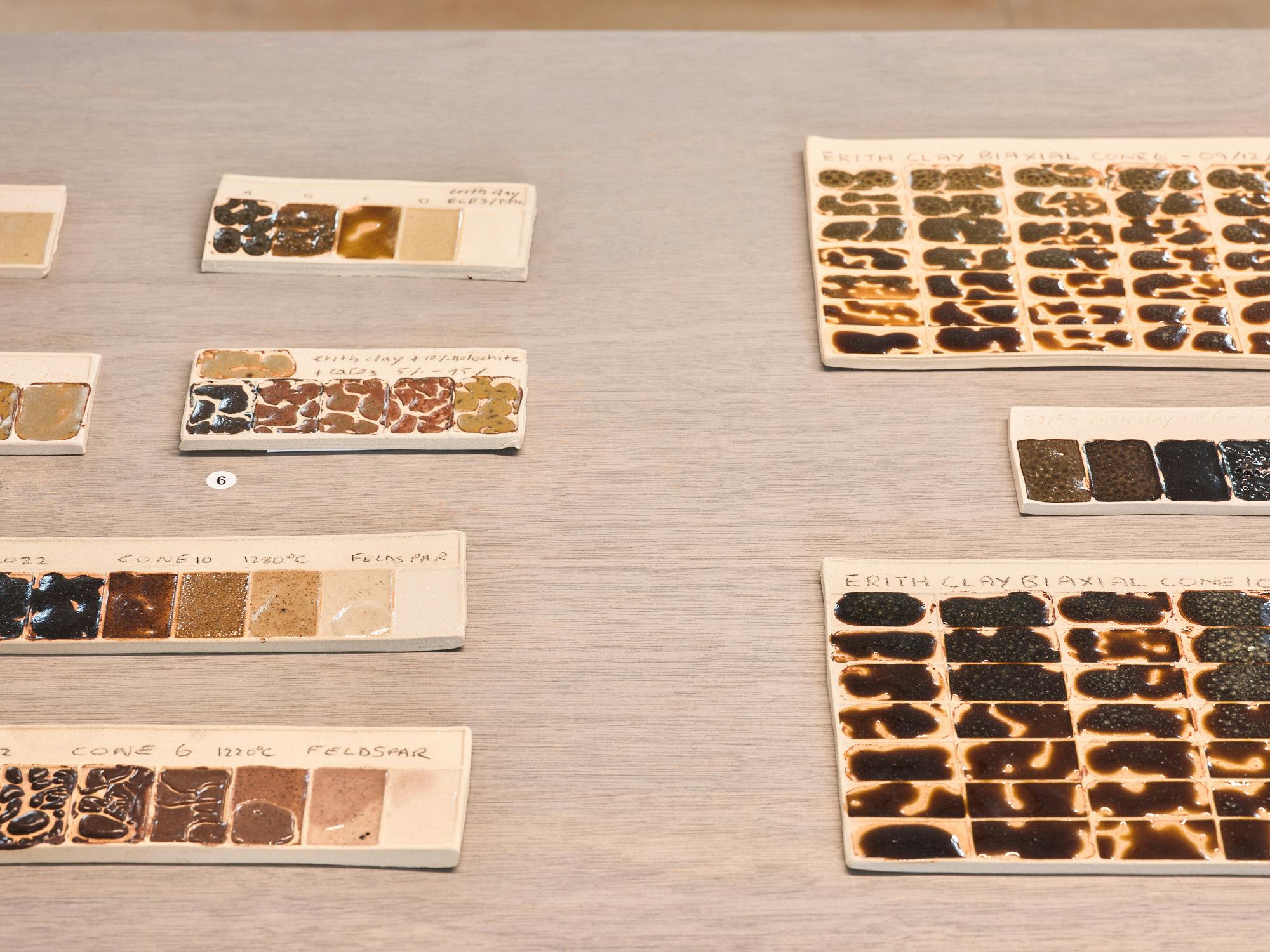
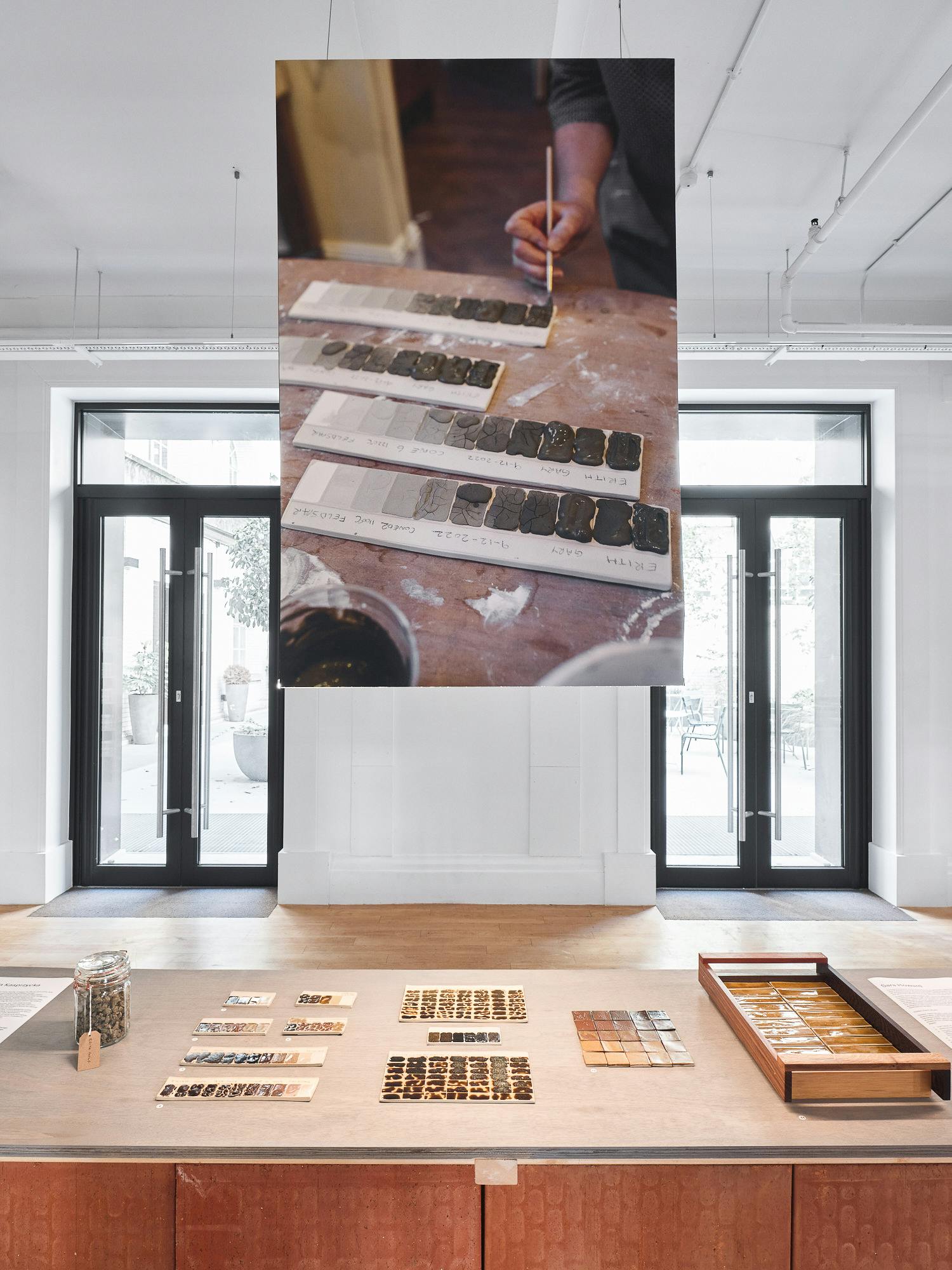
Natalia Kasprzycka. Studio, Stoke-on-Trent. photo Adam Grüning
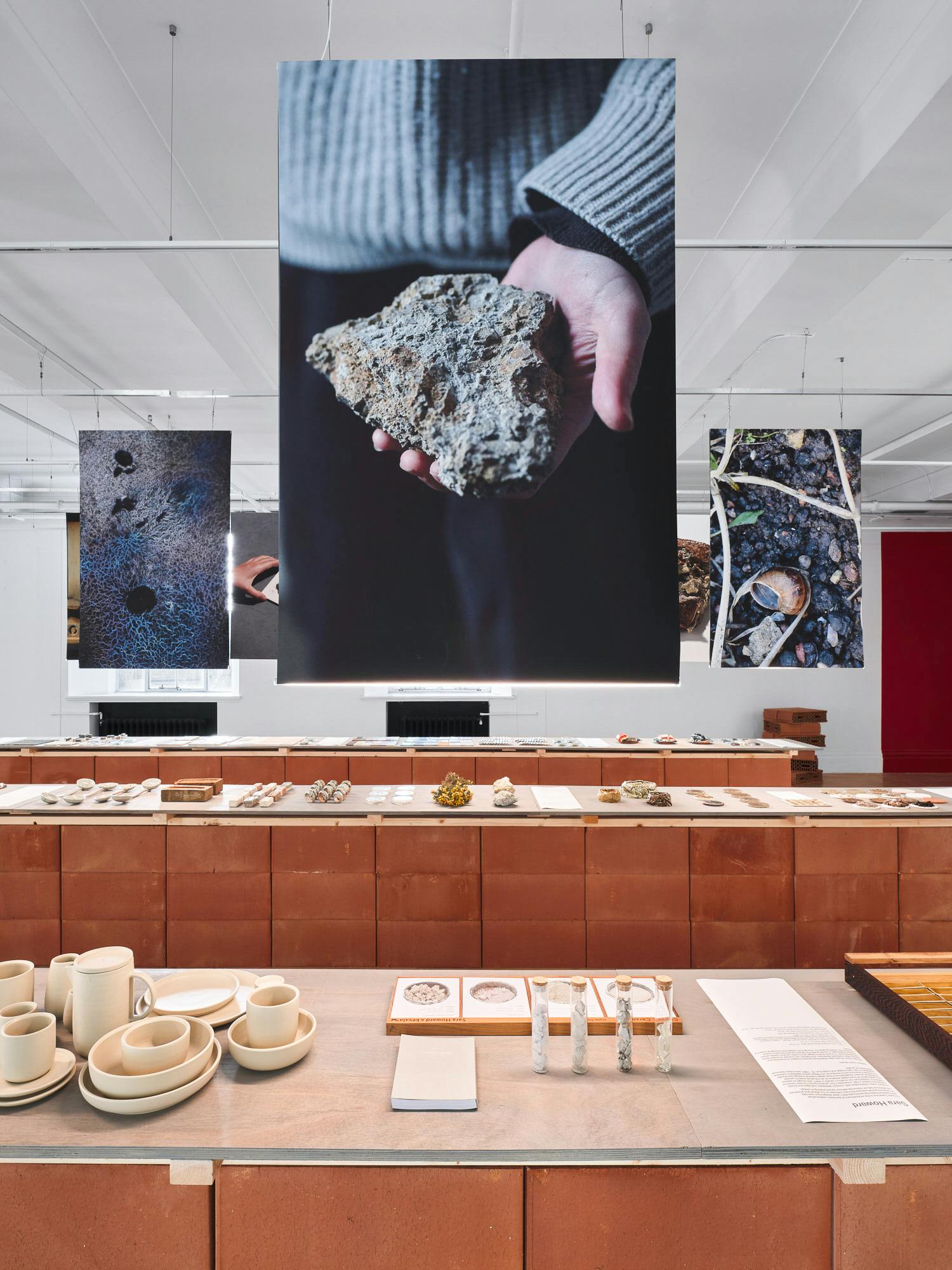
Natalia Kasprzycka. Etruria marl, Stoke-on-Trent. photo Adam Grüning
The Hemmings Tray
Local timber merchants R.I.C. Hemmings have supported the Exchange through timber donations since its early days. In 2021, Rob Hemmings proposed an interesting idea. Over the years, his father Richard, who established the business in 1969, had collected a range of rare and unusual timber, and he wondered if the Exchange could make use of them.
The Exchange wanted to commission something special to showcase the timber and celebrate Richard’s contribution to the community. Design team AtelierThirtyFour created a stacking tray, prototyped in free making workshops at the annual craft festival Here Comes the Sun, and now nearly ready for production. Each tray will be entirely unique, containing unknown and fascinating pieces of timber. They will be sold in memory of Richard, who sadly passed away earlier in 2024, with proceeds supporting free opportunities for local people to learn woodworking skills.
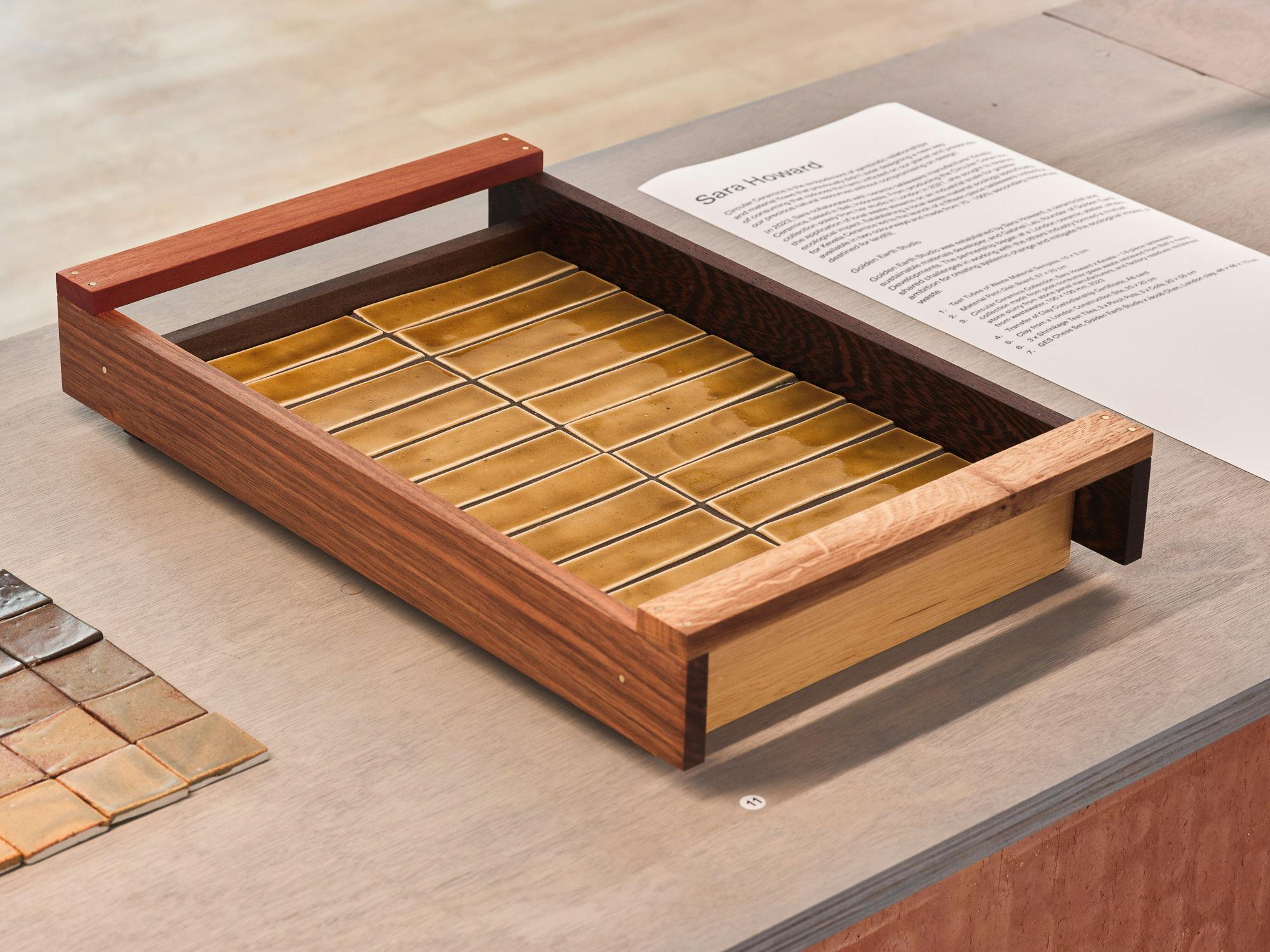
Phil Root
Phil Root’s recent work investigates the transformational parallels between clay and the human body. In a series of sculptural works resembling loaves of bread, he uses glazes made from multivitamin powders and incorporates over-fired bricks to evoke a sense of decomposition and renewal. These "loaves" act as metaphors for nourishment, mortality, and regeneration, drawing visual and symbolic inspiration from The Dance of Death by Hans Holbein and the Bayeux Tapestry’s collapsing horses.
Imagery is initially rendered onto the white clay bricks as delicate drawings or paintings. As the pieces undergo intense wood-firing, these surfaces fracture, distort, or disappear, reflecting the unpredictability of bodily and material transformation. Root integrates peripheral studio materials such as cordierite, alumina hydrate, and ash from living plants to create a complex chemistry during firing. When subjected to extreme heat, these additives melt into a glassy finish that both stabilises and emphasises surface ruptures, simulating alchemical or biological reactions.
The firing process itself is a central element of the work. Each piece is fired in a wood kiln for up to thirty-six hours at temperatures reaching 1,400°C. As oxygen in the kiln depletes, flames consume the chemically bound oxygen in the clay and glazes, pushing the material to its structural and chemical limits. This process produces unpredictable results, recording both destruction and formation. For Root, this is a visceral metaphor for the human body's cycles of entropy and survival.
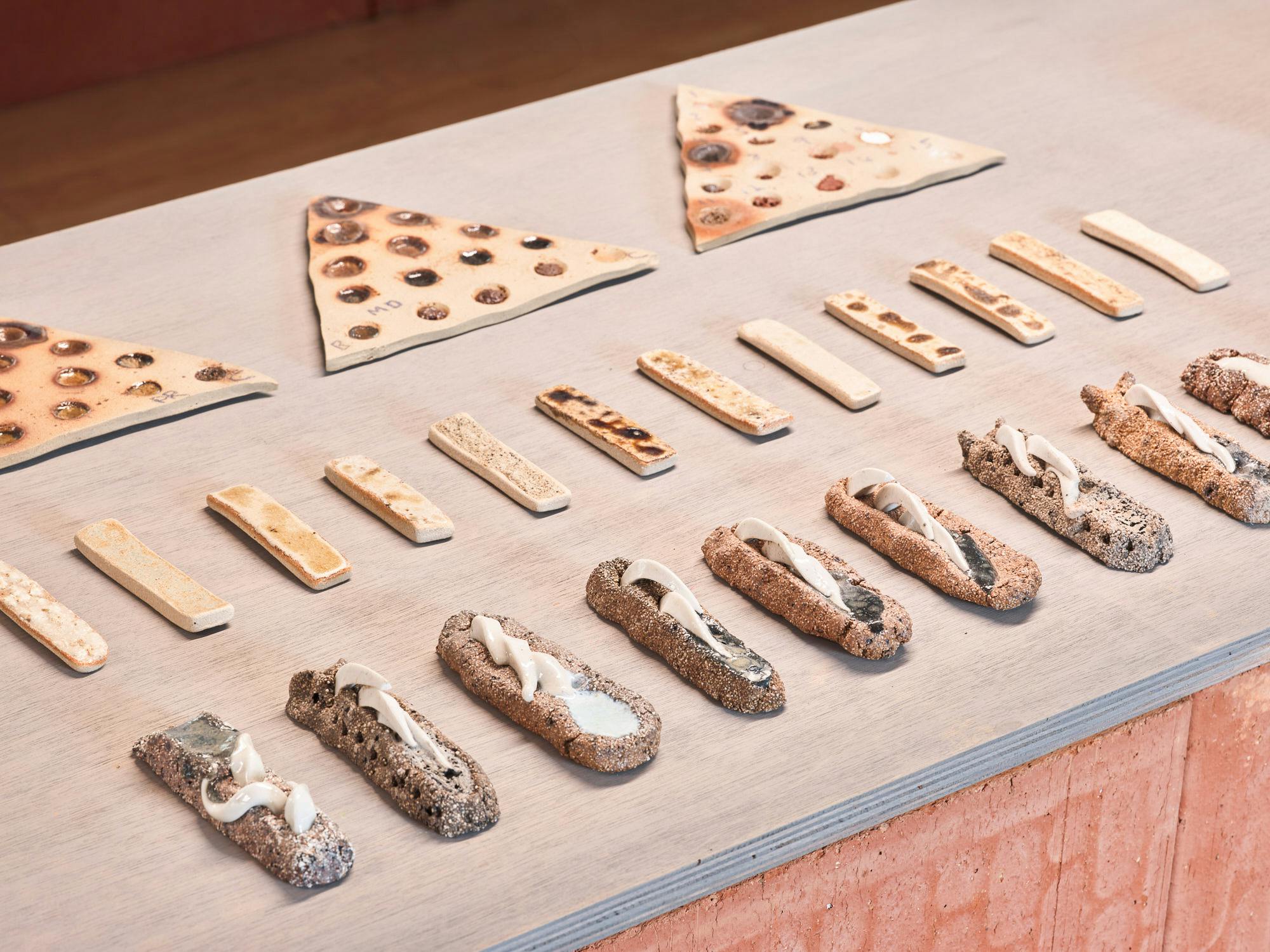
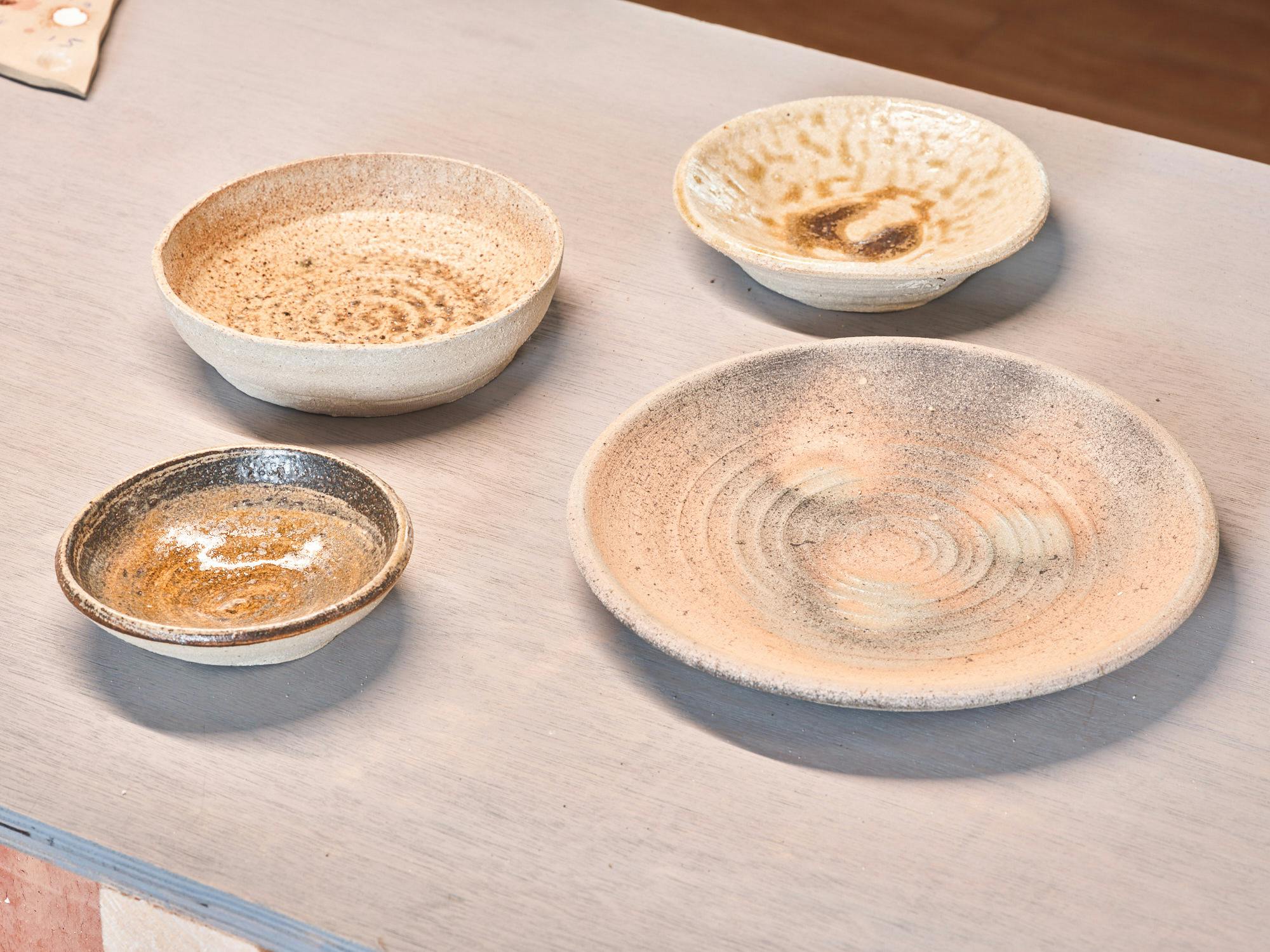
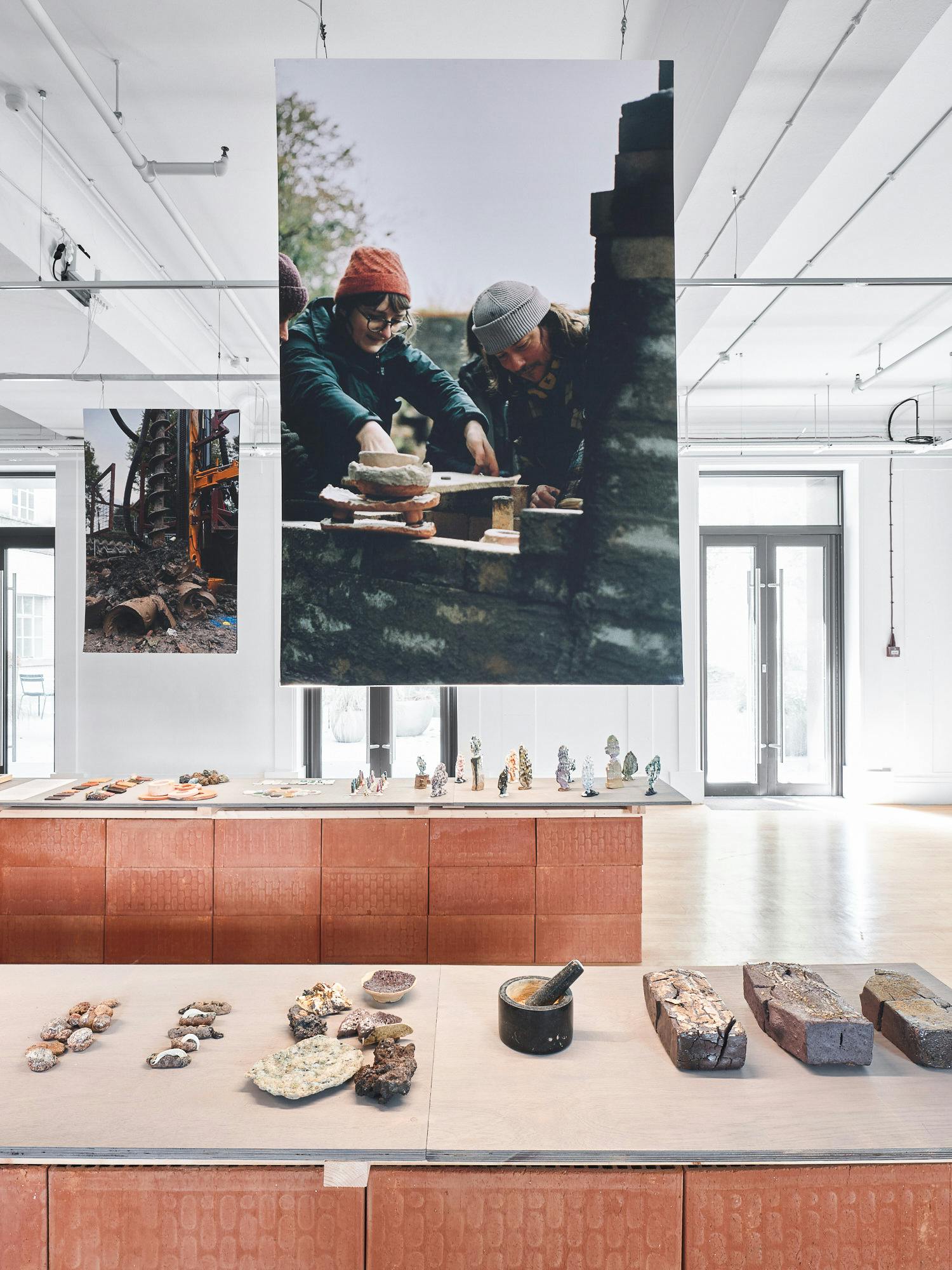
Phil Root. Lyde green pottery, fast fire wood kiln.
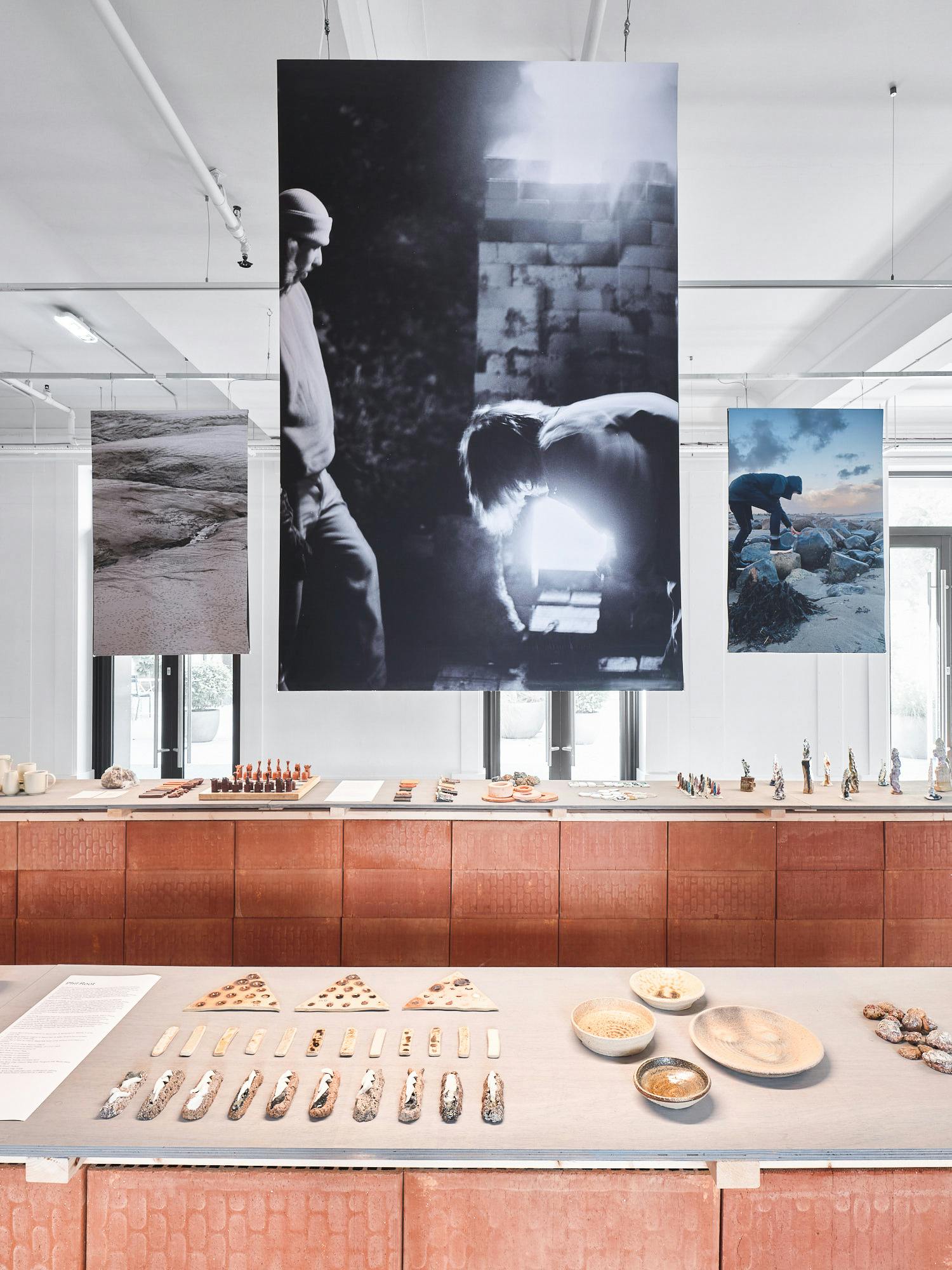
Phil Root. Lyde green pottery, fast fire wood kiln.
Rosanna Martin
Rosanna Martin is an artist, educator and PhD candidate at Falmouth University. She is the co-founder and Creative Director of Brickfield, a participatory brickworks based in Cornwall's china clay landscape that makes use of the waste materials produced by the extraction industry. Her recent sculptural works: evocative of spoons, roundabouts, belly buttons and more explore themes of caregiving and interdependence combining the domestic, the playground and the post-industrial. Created with locally sourced waste clay and glazed using granite dust and gorse ash, her pieces are wood fired and embody a connection between site, material and community.
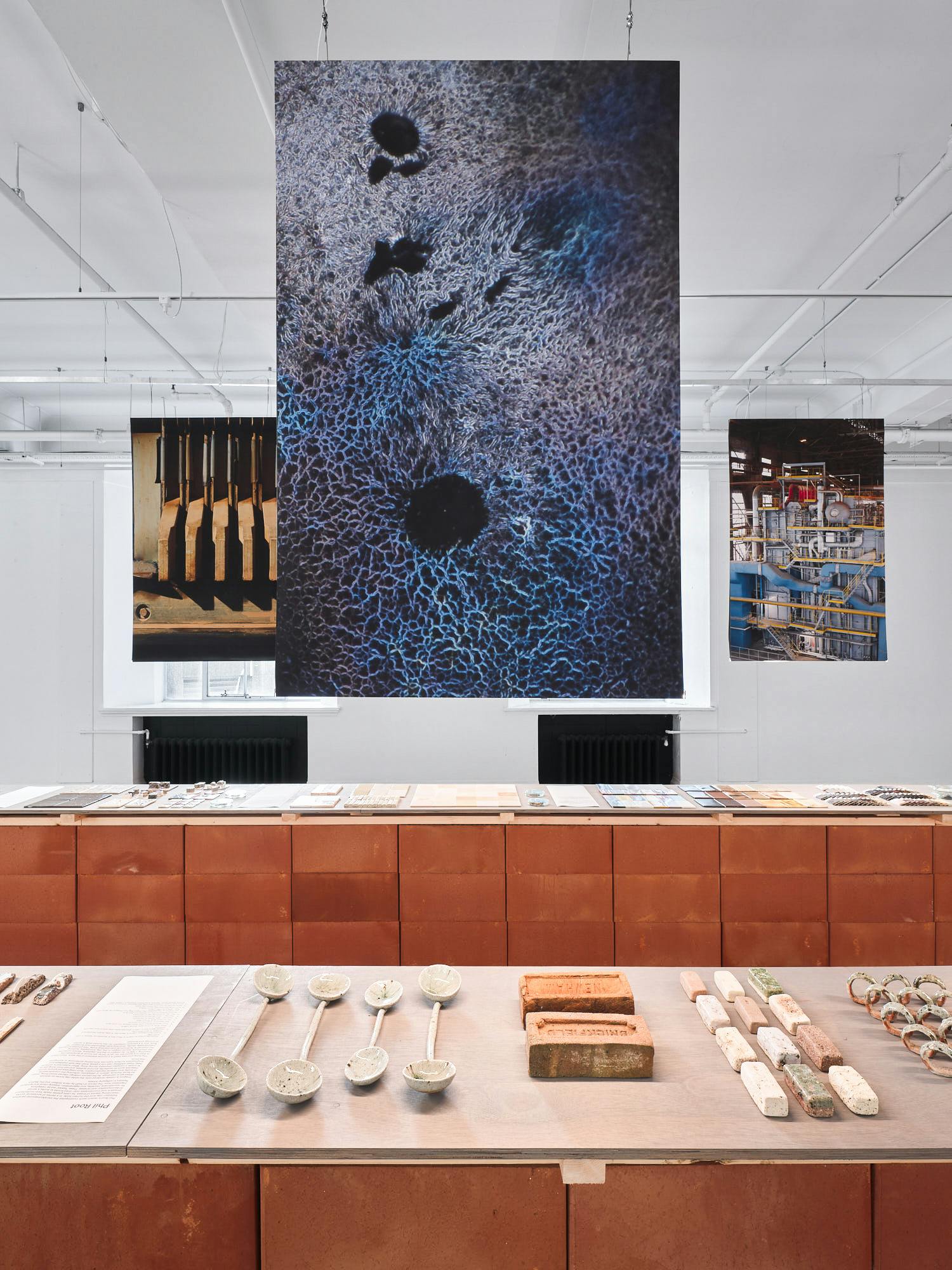
Rosanna Martin. Black Glaze - Microscopic image of a shiny black glaze, taken whilst on residency at Eden Project, Cornwall supported by FoAM.
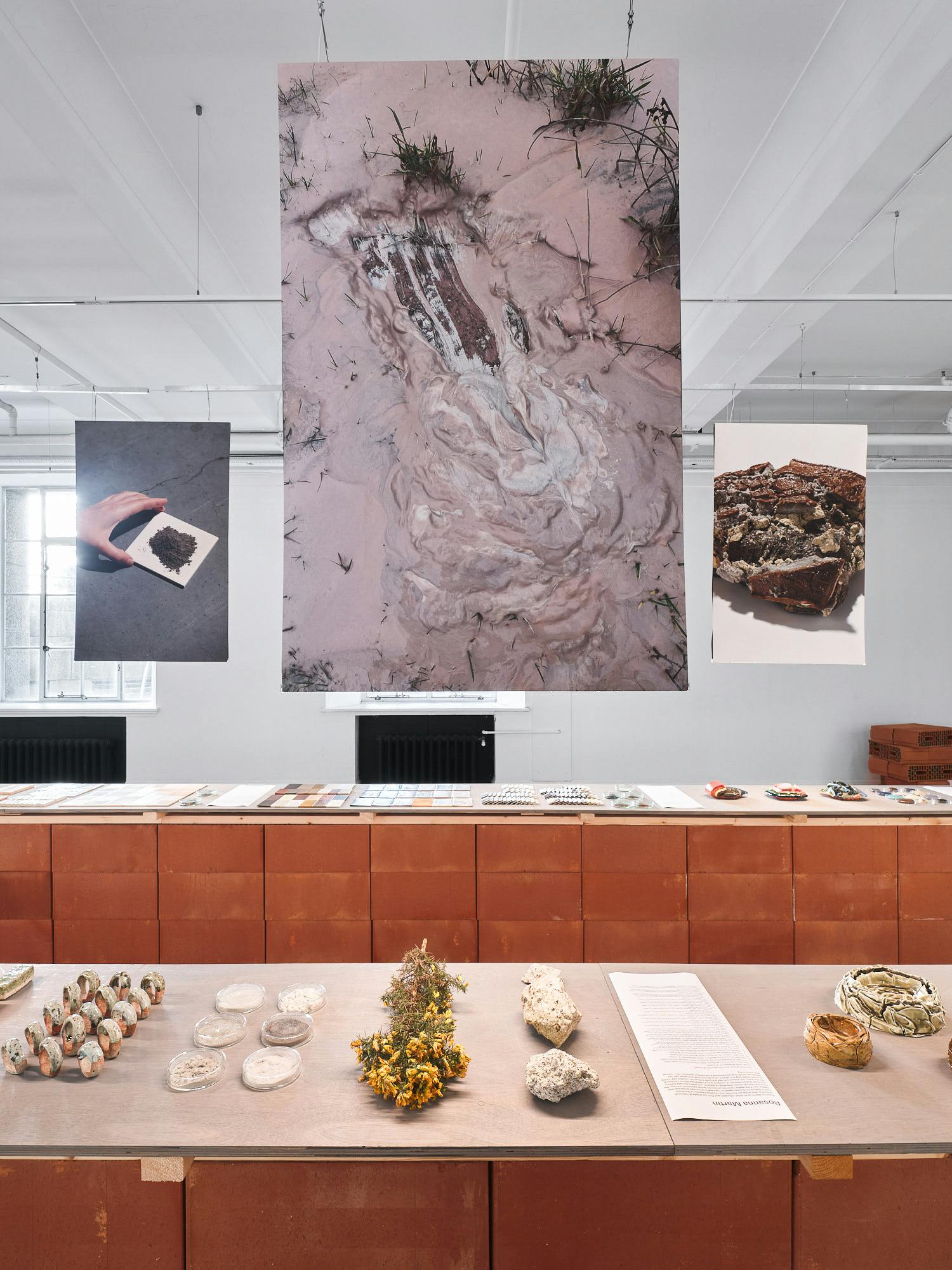
Rosanna Martin. Iron Clay - 'Waste' iron rich clay from the china clay extraction industry. When a clay is found with any iron content in it, it is deemed as waste by the industry and piled up in terraced hills.
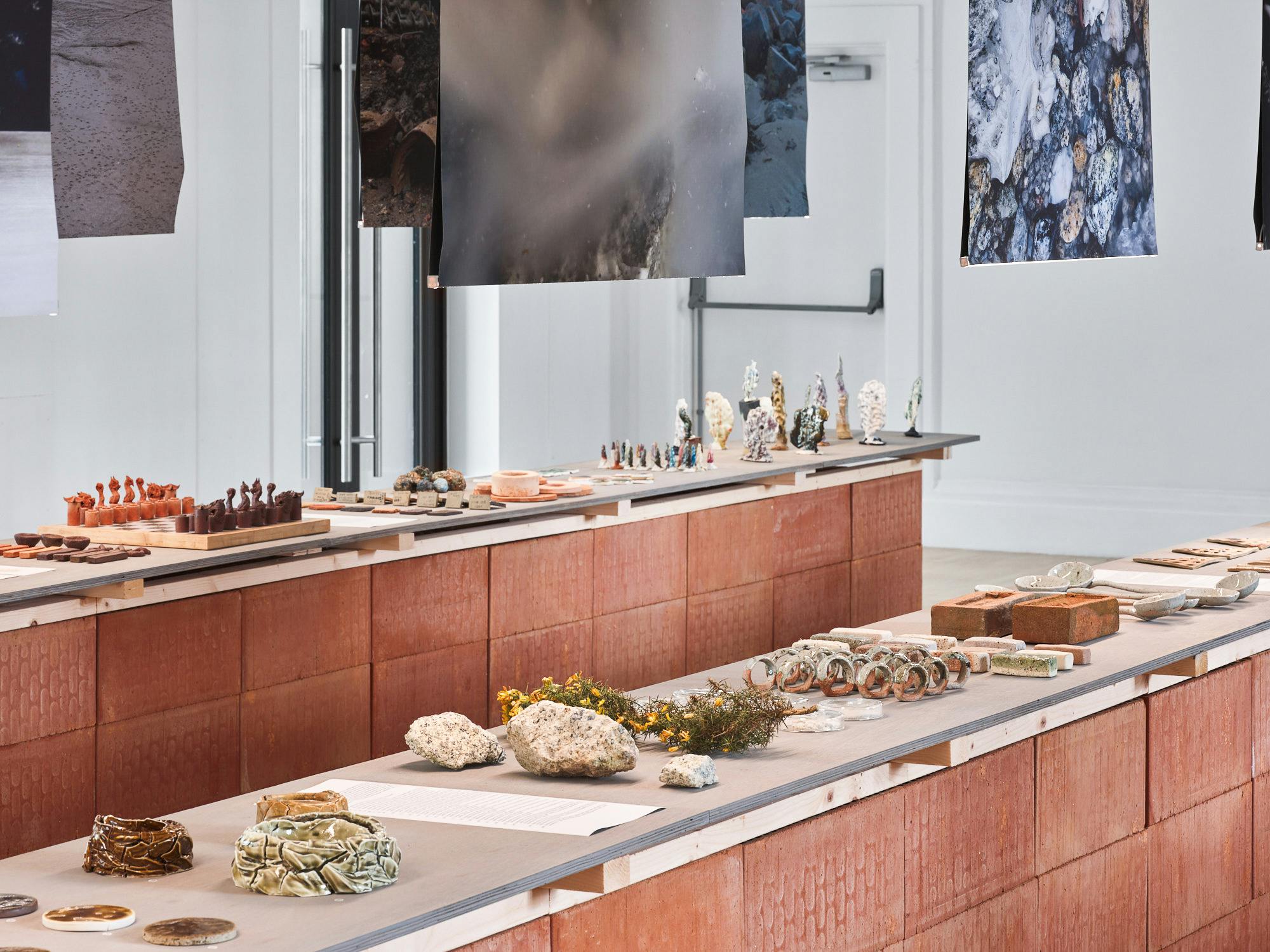
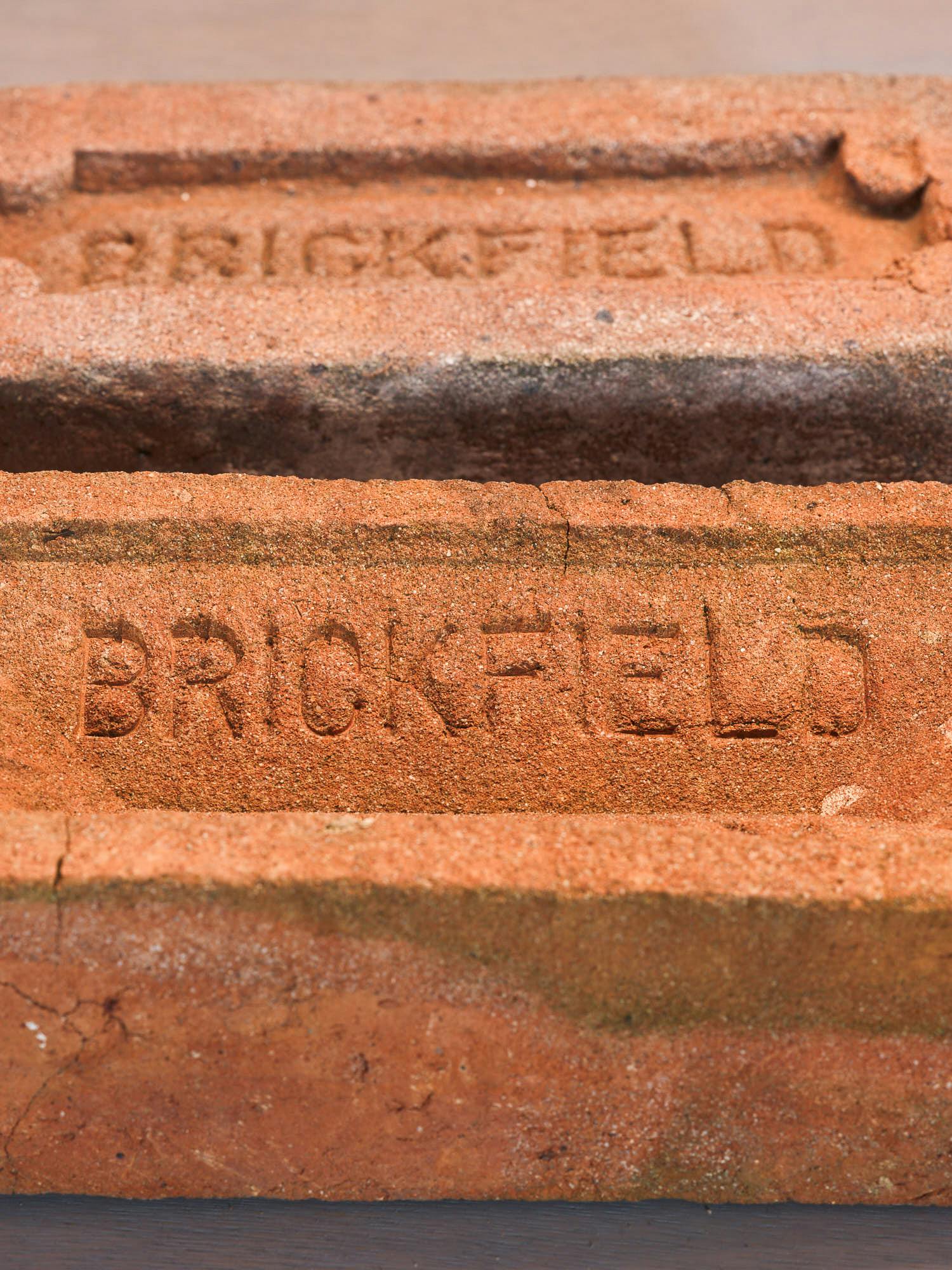
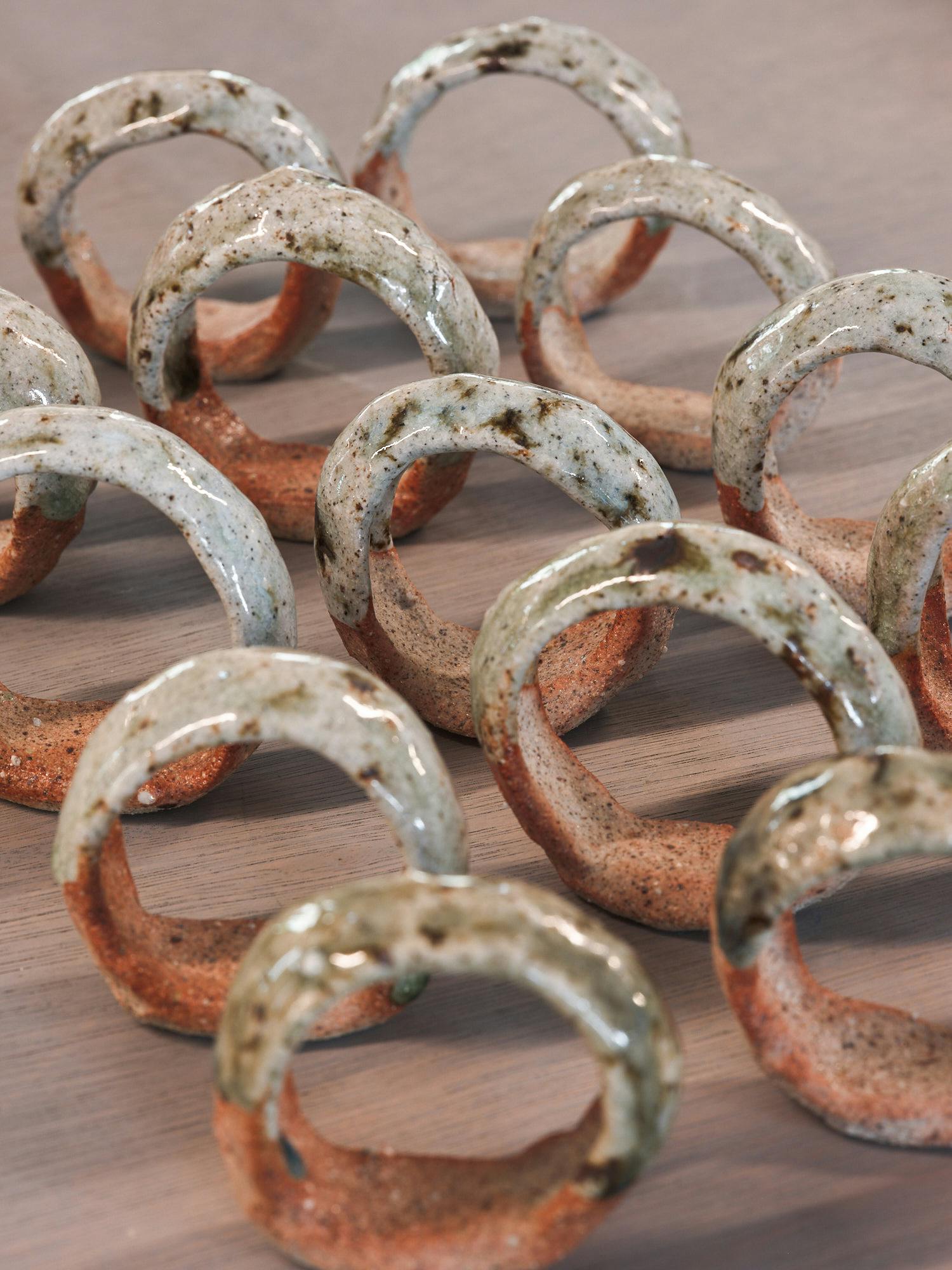
Sara Howard
Circular Ceramics is the embodiment of symbiotic relationships and material flows that previously didn’t exist, designing a new way of consuming that reduces the harm inflicted on our planet and preserves our precious natural resources without compromising on design.
In 2023, Sara collaborated with ceramic tableware manufacturer Kevala Ceramics, based in Bali, Indonesia. From producing the Circular Ceramics collection solely from her studio in London in 2021, she sought to explore the application of local waste streams on an industrial scale for greater ecological impact. Establishing a local waste material ecology specifically for Kevala Ceramics led to the launch of a fifteen-piece tableware collection, available in two colourways and made from 70–100% secondary resources destined for landfill.
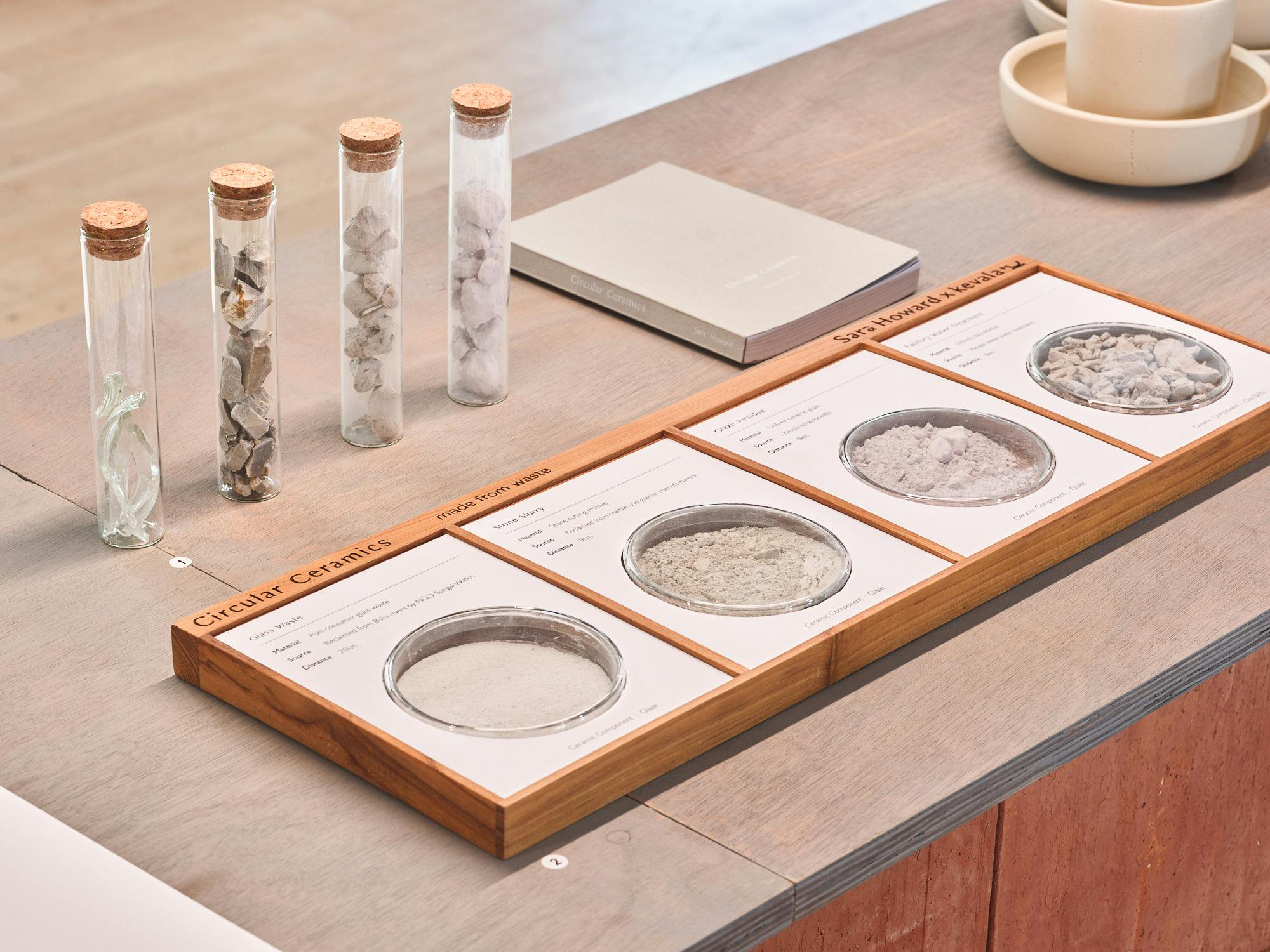
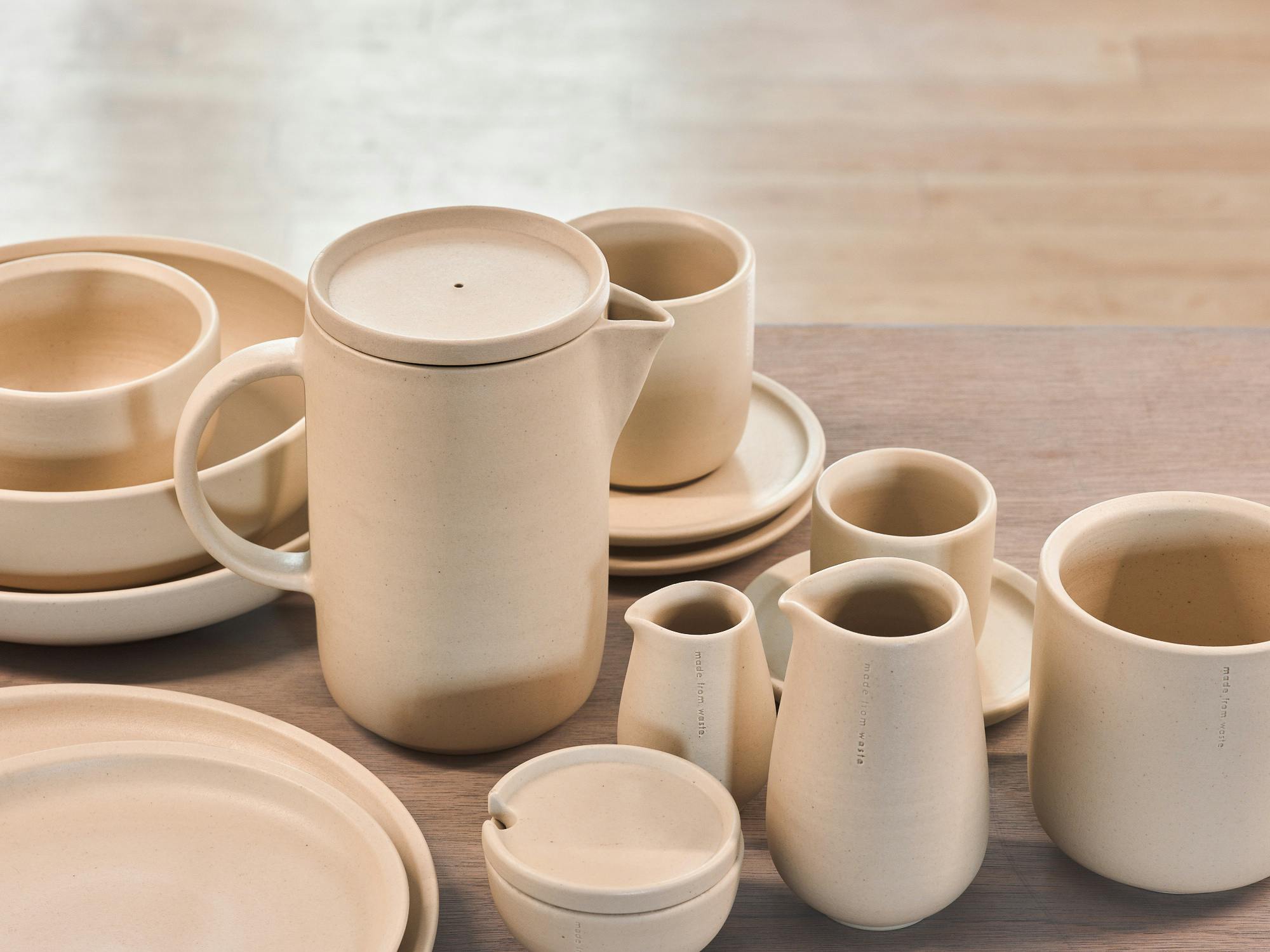
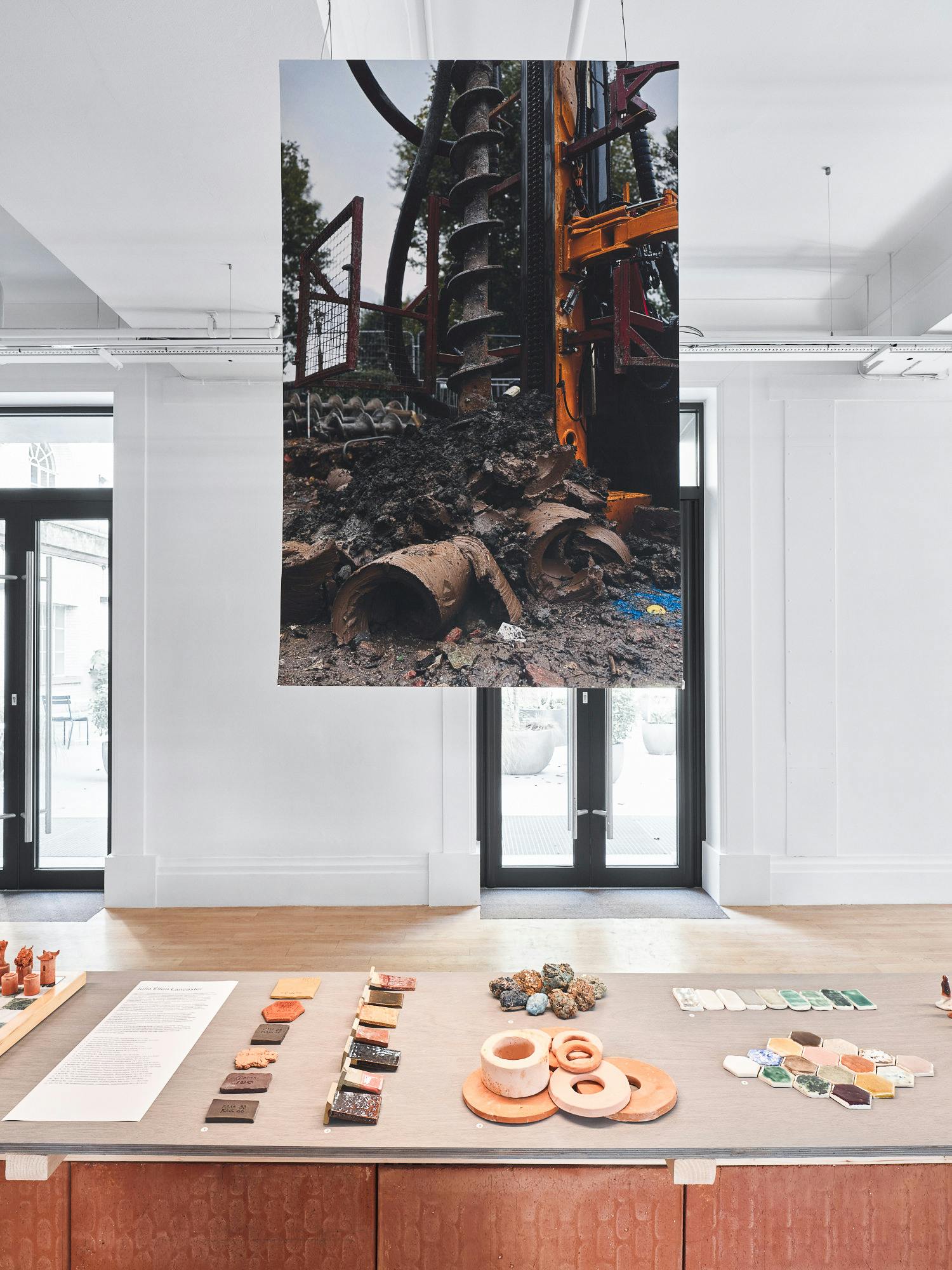
Golden Earth Studio Foundation Pilings for a Residential Home in London
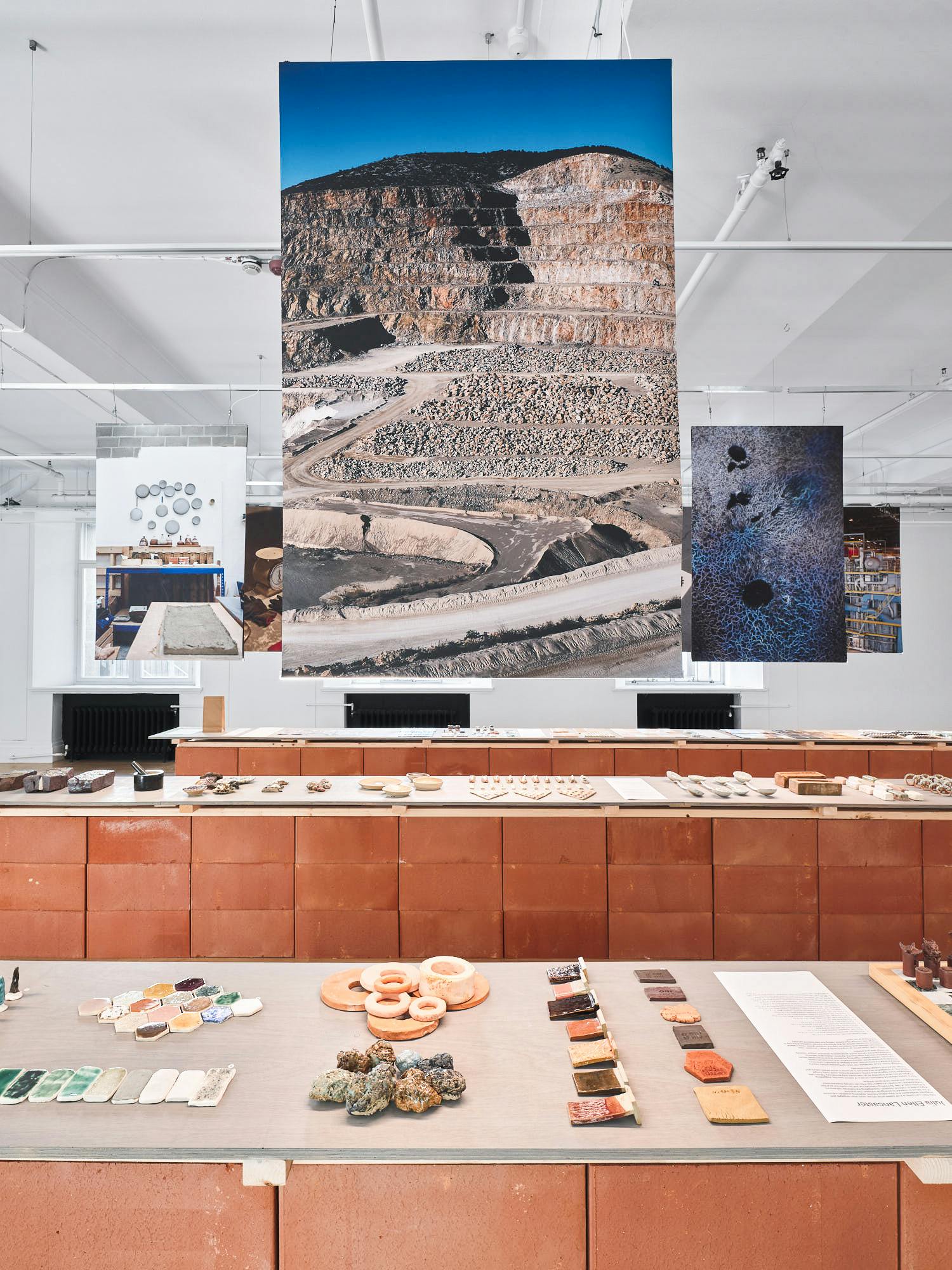
Sara Howard. Vallcarca Quarry, Barcelona. Primarily extracting clay, limestone and iron ore.
Steven Sales
This body of work delves into the complex relationships between place, materials and production. The glazes are comprised of ingredients sourced directly from my home and garden: soil, snail shells and ash from my stove - humble materials that are abundant and intimately tied to my environment.
Glazes respond in nuanced ways to different clay bodies. This series of work seeks to explore the subtleties of those interactions, highlighting the deep connection between material, environment and process.
